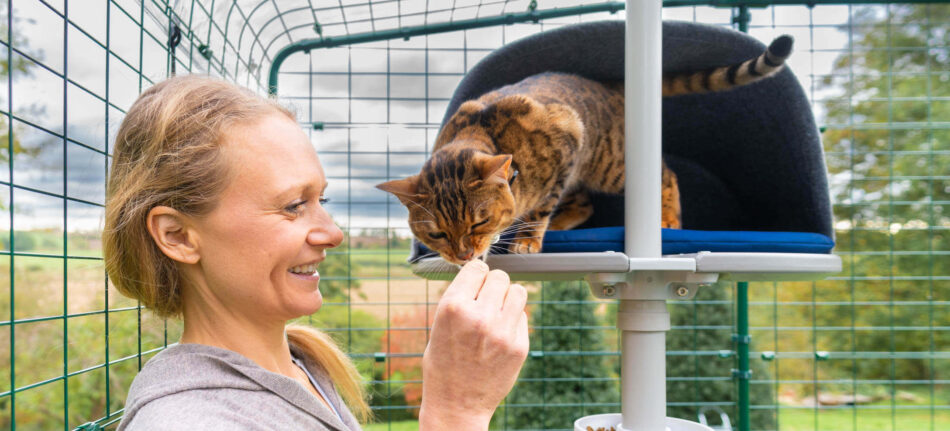
If cats had their own outdoor play space what would it be called? A kitty keeper? Cat crib? Or maybe a meow house?
For decades, one word has been used to describe an outdoor enclosure for cats: “catio”. But what is a catio? A blend of the words cat and patio, a catio is any safe outdoor enclosure for cats. At Omlet, we didn’t invent catios, but we did purrrfect them!
Why are catios so great?
If you are a cat owner then you know first hand that your feline friend appreciates fresh air! Whether it is through an open window or closed screen door, most cats will instinctively move towards the scent and relaxation of outdoor air whenever possible. It makes sense, right? Cats are native to the wild and having the ability to roam and move in an outdoor space feels, well, normal!
So let’s take a closer look at all the reasons why outdoor catios are so great!
- Spacious Outdoor Freedom: With the Catio designed by Omlet, any cat can play safely and freely in the fresh air. The modular design of the outdoor cat enclosure means you can create a catio that suits your specific backyard space and pets! Just check out our easy-to-use Catio Configurator to start creating your own perfect catio!
- Totally Customizable: We not only made the size of the catio completely customizable, but we ensured the overall design was as well! Looking for a way to add additional security to your catio? How about a porch! The Catio Porch designed by Omlet was created with both security and space in mind. The two-way door system allows you to enter the catio at any time without worry of your feline friend trying to join you as you leave!
- Assembly And Look: One quick search on the internet will provide you with dozens of different DIY or custom catio options. Our product engineers had specific objectives in mind when creating the Omlet Catio: an easy to assemble product that was sturdy and unobtrusive. Made from a strong steel mesh that is painted in a natural blending green, the Omlet Catio will not only keep your cats safe, but keep your backyard looking good while doing it, too.
Why should you get a catio?
So you’re looking to add a catio to your outdoor space? Congratulations! The ability to move outdoors is incredibly beneficial for cats. But catios offer so many more benefits to your feline friend.
Safety: By nature, cats are very curious creatures and they love to explore their surroundings by climbing new heights. However, this may sometimes become a danger when done indoors. The greatest benefit of the Outdoor Cat Run Enclosure is the ability for your cat to climb, jump, and run as much as they like without worry of hurting themselves or others. The Catio not only keeps them safe from indoor dangers (like falling bookshelves!), but from outdoor dangers, too (like wild predators!).
Fresh Air: Think about the last time you stepped outside in fresh air and took a deep breath. We know how relaxed you felt! Cats feel the same way! When outdoors, cats receive the same benefits of fresh air that we do – increased circulation, improved mood, and overall better health! What greater gift could you give your cat than a longer, healthier, and happier life?
Happy Neighbors: Being “neighborly” is always the right thing to do! However, letting your cats roam around outside without an enclosure could potentially lead to a case of kitty trespassing. And that’s not very neighborly! Catios are the best of both worlds because they provide the great benefits of being outdoors but within a secure space so your cat can’t end up in someone else’s yard. And your other backyard wildlife, such as birds and chipmunks, will thank you, too! While in a catio, your feline friend is no longer a natural predator to these smaller prey.
How to choose the right catio
If you are a handy human who has great workmanship skills, then building a DIY catio might be the best option for you. But for the rest of us, assembling and installing a custom ready-made Catio is the easiest option!
Backyard catio
The backyard is the most obvious place to put a catio. But you don’t need a huge backyard to create an outdoor cat oasis. In fact, just a small area will work as our Outdoor Run Enclosure can be designed as small or as large as you like!
Here are the simple steps to get started building your own catio:
- Decide where in your backyard you want to place the catio. You can have it freestanding or up against the house for easier indoor/outdoor access.
- Measure the space.
- Choose what size catio you want! You can either pick a pre-configured option ranging from 6’x6’ up to 9’x12’, or customize the length, width or height to your specific needs.
- Order your Catio by Omlet and get ready to give your cat an incredible experience!
Apartment/balcony catio
Is it possible to still have a catio when you live in an apartment or condo? Absolutely! The Cat Balcony Enclosure by Omlet was designed specifically with these dwellers in mind. We made the Balcony Catio narrow enough to fit any size balcony and offer an extendable length option from 6ft-12ft so you can install with ease! This enclosure is a simple solution that allows you to rest assured that your cat will be completely secure in this escape proof design.
How can you customize your catio?
When it comes to adding accessories to your catio, the options are endless! Our product engineers know cats and they created these feline friendly products with your purrfect pal in mind!
Cat tree: Omlet’s Freestyle Outdoor Cat Tree is the number one must-have item to include in your catio! This easy to install pole design is any cat climber’s dream and was created to be the last outdoor cat tree you will ever need! Choose from a wide variety of attachments to add to your Freestyle, such as a hammock, scratching post, or ladder. Your cat will want to spend hours relaxing and being entertained in their catio!
Partitions: What if your catio had multiple rooms? Another great way to customize your catio is by adding partitions. If you have more than one cat, or are looking to add a new feline to the family, this is a great option to allow all paws outdoor play without getting too close.
Weather covers: Rain or shine, your feline will be just fine with Run Covers from Omlet. We know cats don’t like to get wet and too much heat on a sunny day is not favorable! So adding weather covers to your catio will keep your cat happy while they still get to enjoy their outdoor space.
So now that you know what a catio is, you are fully equipped with all you need to create an outdoor cat kingdom! And even though your cat may still think every room on the inside of your home belongs to them, they will love their catio for the dedicated space that is completely their own!
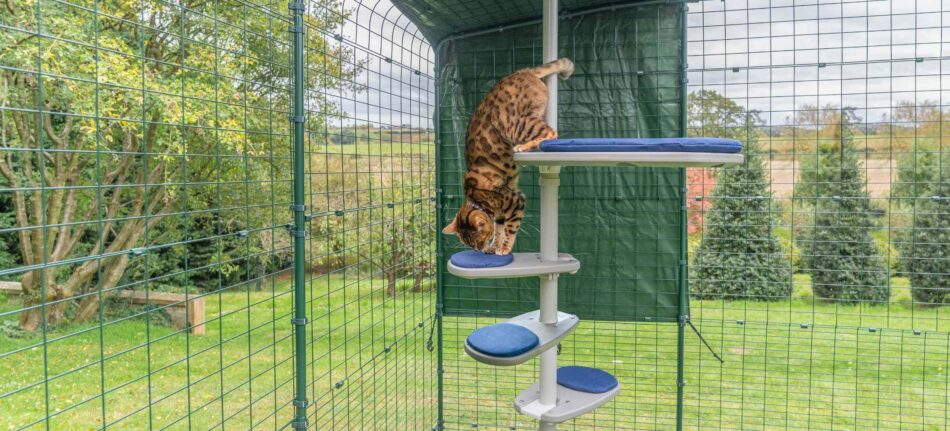
This entry was posted in Cats
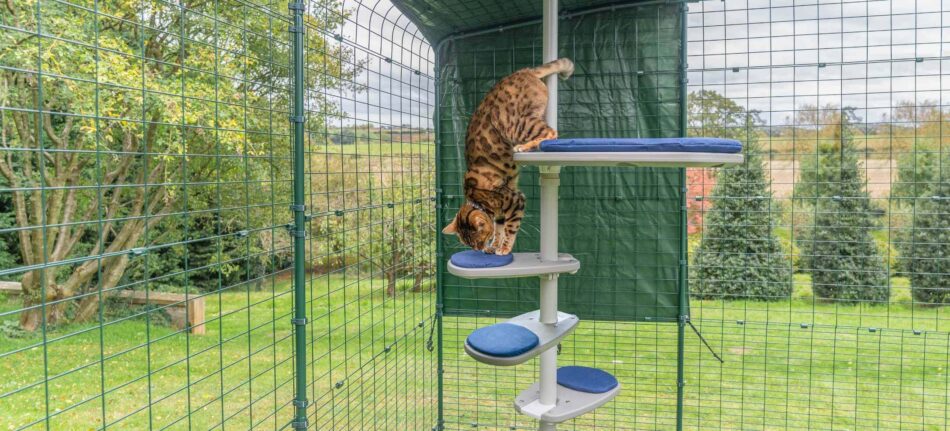
Catios have become increasingly popular among feline owners! These enclosed outdoor spaces are the perfect way to let your cat enjoy the benefits of fresh air but with the safety and protection from outside dangers or predators.
Whether you have a small apartment in the city or a large backyard in the country, you can create a catio of any size to suit your furry feline friend! And we have all the outdoor catio ideas you need to get started!
So, what exactly is a catio?
The word “catio” came from the idea of a patio for cats (cat + patio = catio). In basic terms, a catio is a safely enclosed outdoor space where cats can enjoy the sunshine and fresh air without you worrying about them getting hurt. But why are they important for cats?
- Protection of your cat: Cats are curious by nature. The number one reason cat owners have a catio is to let their cats be outside safely, allowing their curiosity to shine!
- Protection of wildlife: A catio protects other wildlife, like birds and chipmunks, from your cat! Remember that cats are predators themselves by nature, so when given the chance to roam outside, their instincts will kick in! So be sure to have an enclosed space for them to enjoy!
- Healthy lifestyle: There’s no denying that everyone feels better when outside and in sunshine! Cats feel the same way, too! And when they are exposed to fresh air and movement on a regular basis, they live a longer and healthier life as a result.
- Reduction of indoor smells: Is your indoor litter box starting to smell too much? A great benefit of outdoor catios is that they provide another spot for your litter box. This way, the smells can stay outside!
- Keeps neighbors happy: Stop kitty trespassing! The catio is the perfect solution to let your cat enjoy the outdoors without roaming into your neighbor’s yard!
Catio ideas for backyards
You don’t need a huge backyard to create a wonderful catio space – even just a small area will do! Outdoor catios can be as small or as big as you like and can even be customized to provide one-on-one outdoor bonding time with your cat! Let’s take a look at all the catio ideas for backyard spaces:
Freestanding catio: At Omlet, we didn’t create the Catio, we purrfected it! With our customizable cat run we designed a safely enclosed outdoor space that both you and your cat can enjoy! Place a cat tree inside for your cat to climb and a bench swing for you to sit and enjoy watching! Outdoor bonding with your cat has never felt so good! This sturdy and spacious enclosure has been rigorously tested and is the safest and most easy to use catio on the market!
Catio attached to house: What if you are stuck working inside when your cat wants to go outside to play? Don’t you want to enjoy that fresh air, too? Well, you can! There are several DIY solutions to attach the Omlet Catio to your home, allowing you to leave a space open so your cat can move freely between the inside and outside. Some options include building a mesh tunnel from a window into the catio or just simply move the Omlet Catio up against the house so your door opens directly into the enclosure. The options are endless when creating backyard catio ideas!
Catio ideas for apartment balcony
Don’t let where you live dictate where your cat can go! The Cat Balcony Enclosure designed by Omlet provides a simple, yet elegant solution to outdoor cat living. This fully secure and escape proof catio fits on almost any size balcony and can be customized to suit your exact needs.
Attach a hammock to a cat tree so your cat can lounge around and add a bean bag chair in the corner so you can take an outdoor cat nap, too! And if you are worried your cat might try and escape when you open the door, just add a porch to have an additional layer of security!
The Cat Balcony gives your cat the freedom to explore the outdoors without the compromise of space!
Catio decorating ideas
Decorating your catio is part of the fun of owning one! Let’s take a look at these feline friendly decorating ideas!
Outdoor cat tree
The Freestyle Outdoor Cat Tree designed by Omlet is a great addition to any outdoor cat enclosure. Completely customizable with all things that cats love, this outdoor cat tree will allow your feline friend to explore so many new heights and sights. From platforms to scratching posts, the options are endless with what you can create!
Partitions
The Catio Outdoor Partition designed by Omlet is made from the same strong steel mesh as the catio enclosure. This secure and lockable door gives you the ability to create sections for multiple cats. Whether you are introducing a new cat to the crew or just wanting to create separate eating spaces, this partition provides the necessary separation with ease!
Weather covers
Cats like to be outdoors, but they hate getting wet! Adding a heavy duty tarp to the top of the catio gives your cat the best of both worlds! The Omlet product designers created this cover to specifically fit the catio and made it incredibly easy to install and maintain. Not only will it keep your cat dry when it rains, but it will also provide much needed shade when the sunny days are too hot!
The added stimulation and benefits that cats receive from being in an outdoor enclosure are numerous. And as a pet owner, you can create a custom outdoor cat paradise with all of these catio ideas!
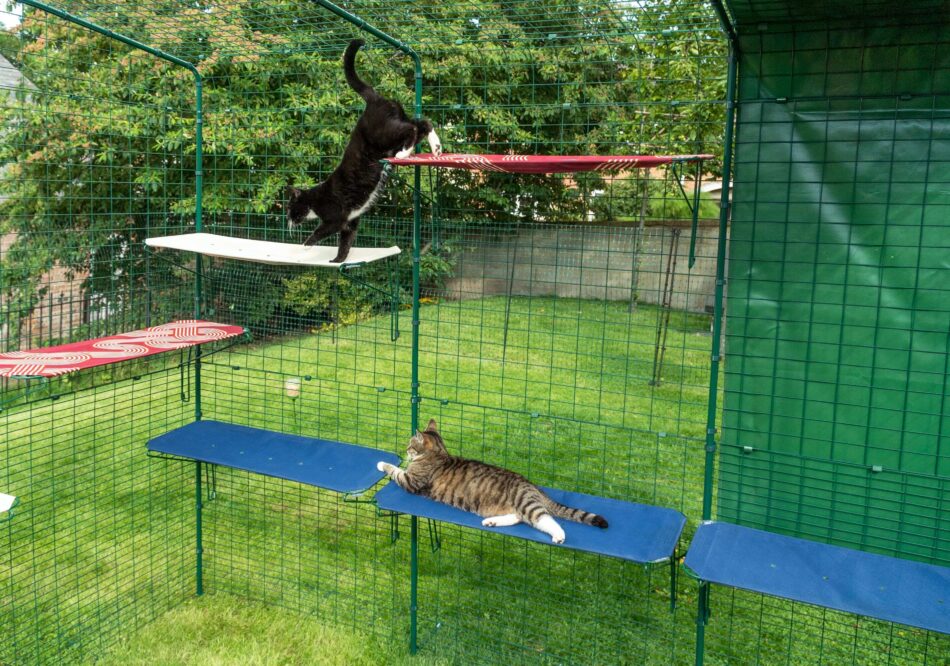
This entry was posted in Cats
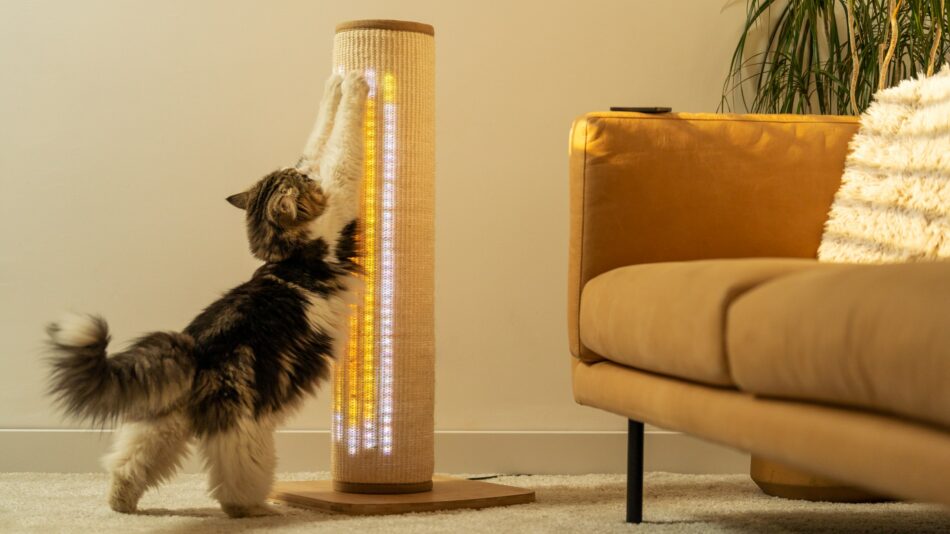
You’ve searched high and low and finally found your new feline friend to be your forever bestie – congratulations. But wait – do you have everything you need to make your new cat feel at home? Have you prepped your house with all the necessary new cat essentials? Don’t fret – we have you covered. Before you go buying too much kitty litter, take a look at this new cat checklist to make sure your feline friend has everything they need before they move in.
Food
It should go without saying that food and water are essentials to have plenty of when bringing home a new cat. But how do you know what food to buy? Cats and kittens need different food as the digestive systems of kittens are still developing and require a more specialized diet.
While there are many brands and options of cat food to choose from, it’s important that you find one that has the ingredient taurine. An amino acid that makes up proteins in plants and animals, taurine is essential in a cat’s diet to aid in heart, retinal, and digestive functions.
Feeding your cat an all-vegetarian diet is a no-no. Cats are one of the truest carnivore animals and they require protein in their diet to keep them healthy. So be sure you read the labels before buying their food.
It’s also important to remember that cats are curious by nature and like to bat objects with their paws…such as food bowls. So be sure to have sturdy pet bowls that won’t tip over and are also easy to clean.
Litter box
Ah, the kitty litter box. If you’ve ever been a cat parent then you know all too well just how essential this item is. We have to remind ourselves that litter boxes are the equivalent to our favorite bathroom in the house. So when it comes to buying the right litter box for your new cat, size matters.
The general rule of thumb is to buy a litter box that’s 1 ½ times the length of your cat. Your feline friend is fickle and doesn’t want to feel cramped when using the toilet. And can you really blame them? Since this is the spot where your cat will do all their “business”, adding some privacy with an enclosed cat litter box is always a good idea.
The Omlet Maya Cat Litter Box is a great option as it offers a range of entry-point options to suit any cat. The sleek enclosed design not only minimizes smells and messes, but doubles as a piece of furniture for your interior design. And speaking of smells, check out these scented cat litters that are not only a healthy choice for your nose, but for your cat and the environment as well.
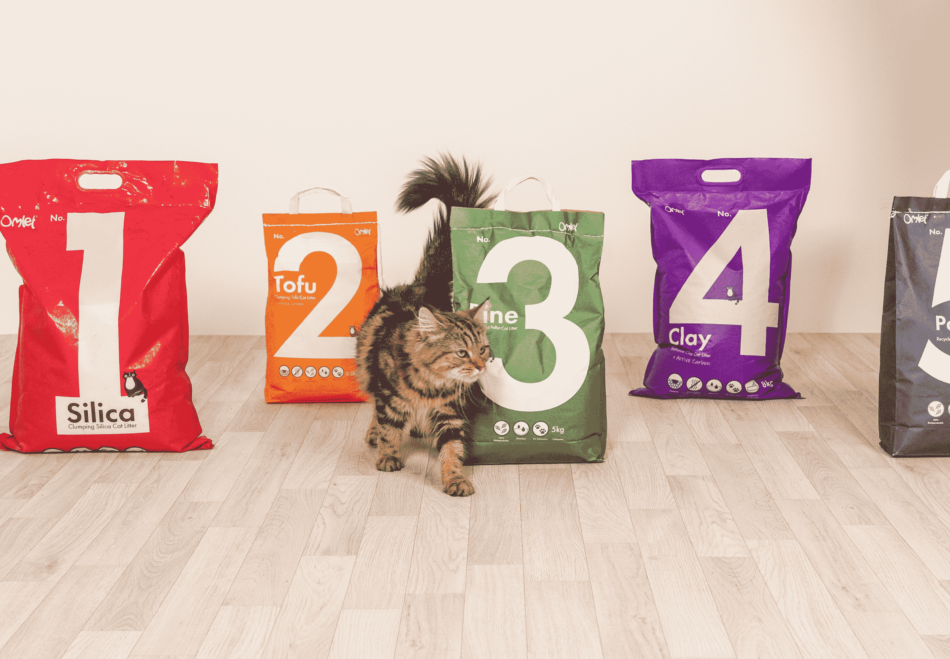
Grooming and hygiene
Believe it or not, one of the best bonding activities for you to do with your cat is to brush them. Yes, that’s right, while cats typically do self-grooming all day long, they actually love the sensation of being groomed. And long-haired cats, like Persians or Maine Coons, need daily attention to their coats to keep them healthy. So be sure you have a good comb or brush to help your cat stay tangle-free.
When it comes to baths and nail trimming, sometimes this is best left to the professionals like your veterinarian or a professional groomer. It’s important to keep these essential hygiene needs as positive experiences, so if you feel you are unable to handle a cat in the water, then seek advice from your vet for options.
Cat toys
There really is no better way to form a long-lasting bond with your cat than through play. Cats are predatory by nature and have instinctual needs to release bursts of energy. Playing also helps your cat to relieve any boredom that could lead to too much curiosity. And what better way to give your cat some good exercise than through a fun play session.
At Omlet, our mission is to rethink every aspect of caring for your cat. So we engineered a revolutionary product that meets your cat’s every need with technology that brings you both closer together. Meet the Switch Sisal Cat Scratching Post, designed by Omlet – a one-of-its-kind cat scratching post that has integrated LED lights to bust your cat’s boredom and connect you with them in color. Engage all of your cat’s senses with the cat scratching post that will provide endless hours of fun and function.
Also, be sure you have plenty of cat toys on hand before bringing your new cat home and then take some time each day to engage with your cat. The mental and physical stimulation they will receive in just 10 minutes of play each day will be beneficial for their lifetime.
Cat bed
Cats like to sleep…a lot. So one of your new cat’s key essentials is a bed. But not just any bed will do. In the wild, cats often sleep in elevated places to avoid predators or in homemade dens to feel comforted and secluded. So when buying the right bed for your cat, be sure you find one that suits their specific needs.
The Omlet Maya Donut Elevated Cat Bed is a perfect option as it addresses your cat’s specific needs for support and comfort. This cozy, ultra-soft cat bed delivers a first-class sleeping experience to any cat. With a slight elevation and nested cushioning, your cat will find this bed to be the best cat nap spot in the house. And bonus – the cover is machine washable so you can keep your cat and their sleeping quarters clean.
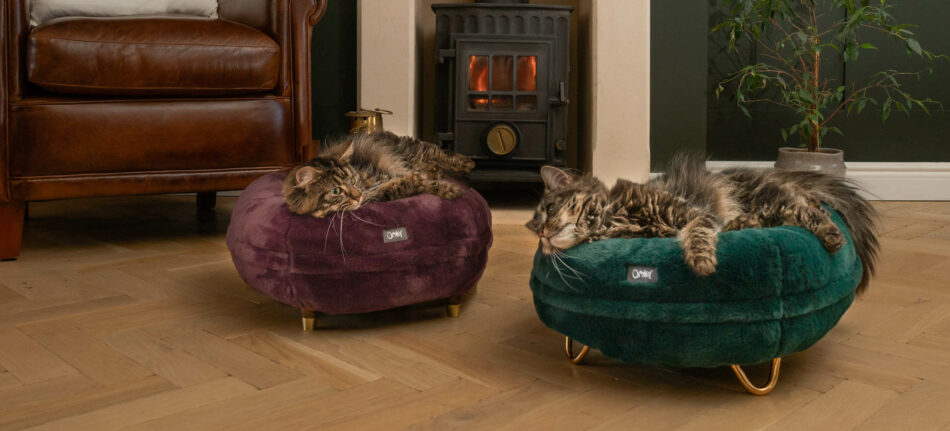
Cat tree
If you want to keep your furniture free from scratches, then you’ll need to invest in a good cat tree. Not only do they allow your cat the ability to get out any stress or anxiety through scratching, but cat trees offer a multitude of other benefits. Just like in nature, cats like to have a top-down viewpoint of their surroundings to feel safe and secure. A cat tree gives them the ability to get up high and escape in solitary when needed.
The Omlet Freestyle Indoor Cat Tree is your one-stop shop for cat tree needs. This fully customizable cat tower is any feline’s fantasy. While most cat trees can be bulky and take up a lot of space, the Freestyle Cat Tree efficiently provides your cat with all their climbing and jumping desires. The unique sleek design, complete with plant pots, makes this cat tree a wonderful addition to your interior that both you and your cat will love.
In addition, this cat climbing tower is available to customize with almost every accessory imaginable. From hammocks to cushioned platforms, your cat will be wildly engaged and entertained all day.
Outdoor essentials
Fresh air and a dose of warm sunshine isn’t just good for us humans – it’s important for our cats as well. In fact, the benefits of fresh air for your cat are incredible and help to provide a healthier and longer life. But how do you safely let your cat explore the outdoors? Answer: with an outdoor cat enclosure.
Unlike dogs, domesticated cats are not as easy to train with sit and stay commands. In order for them to safely explore the outdoors, they need to be in a secure and enclosed space that will offer them protection. The Omlet Catio is the perfect outdoor enclosure solution. This spacious modular design allows your cat the ability to roam and jump freely without the worry of getting lost or entangled with the neighbor’s dog.
And don’t worry if you don’t have a backyard big enough. The Omlet Cat Balcony Enclosure allows your feline friend the same freedom to explore the outside world safely. Just secure this enclosure to your apartment walls and your cat will be exploring new heights and sights in no time.
Omlet and your cat
Becoming a cat owner is one of life’s greatest gifts – for both you and your feline friend. With proper planning and product essentials, you can give your new cat a life full of joy, which they’ll undoubtedly return back to you in the form of comfort and companionship. At Omlet, we know how special that bond between human and pet is so we design our cat beds, cat scratching posts and cat trees to reflect what your cat needs in a way that brings you both closer together. Because perhaps one of the greatest essentials to have on hand with a new cat is in fact love.

This entry was posted in Cats
Cats are incredible jumpers! In fact, most can jump anywhere between 6 to 12 feet in a single leap! But they are also wildly fascinated about the outside world.
So what do you do if you own a cat and your only outdoor space is a balcony? Is it safe to let your cat out on the balcony to explore? The short answer is, yes, but only if you have safety measures in place! The Omlet Product Engineers have created a solution that not only allows your indoor cat the freedom to explore the outside, but with the safety and security to do so!
Let’s jump into the details!

Why cat proof a balcony?
Before we look into cat-proofing options, let’s first explore why you want to create a cat safe balcony in the first place. If you live in an apartment or condo with a walk-out balcony, chances are you enjoy that outside space! Guess what? Your cat will enjoy it as well! But why do cats like to be outside?
Fresh air: We love to get outside to breathe in some fresh air and our furry feline friends are no different. A big dose of breezy clean air coupled with a shower of warm sunshine does anybody, or cat, good! Breathing in fresh oxygen stimulates the organs and blood vessels, providing for a healthier overall nervous system.
Stimulation: Think about the first things you do when you walk outside. You look, listen, and smell your immediate surroundings. Cats are the same way – only on a whole other level since their sense of smell is much more keen than humans! Being outside provides a cat’s senses with invaluable stimulation. They can watch cars driving by, or listen to birds singing in the trees, or just sniff away at the fragrance of flowers growing in the garden. Or, they may just do what cats often do best – sunbathe while taking a cat nap!
Exercise: Even if your cat gets plenty of playtime with their toys indoors, their minds and bodies are built to investigate the world around them. When a cat is able to explore a safely enclosed balcony, they can activate their innate exercise habits like jumping and running. And what better way for your active cat to stay vibrant and young than exploring and moving in a safely secured area!
Creating a safe balcony enclosure
The key to creating a safe outdoor space for your cat is security! Both you and your cat want reassurance that they can freely jump and play without the worry of falling off the edge of the balcony. So how do you make this happen?
The very first step in cat-proofing your balcony is to clear away any items that could potentially be harmful to your feline friend. Make sure none of these items are on your balcony:
- Plants: Cats can get bored and when they do, they often like to chew on anything they can find – including plants! However, some common household plants can be potentially toxic to cats. So in order to ensure your balcony is cat-friendly, take some time to familiarize yourself with which plants are safe for your feline friend, and remove the ones that are not safe from your balcony.
- Cords: Cats are quite curious by nature, so any time they see an item that is new and unfamiliar, they will likely use their sense of taste to first explore. Electrical cords can be very harmful to cats as chewing on them can cause burns inside their mouth. In fact, even unplugged cords can be potentially dangerous so it’s best to remove any and all cords from the balcony.
- Bug repellents, cleaners, etc: While bug sprays are efficient in helping to keep the annoying flying insects off of us, they can be quite harmful to cats. Most bug repellents have DEET as the main ingredient which has proven to be dangerous for cats if ingested. Likewise, many cleaning solutions contain ingredients that could cause issues for interested cats, so it’s best to eliminate them from the balcony altogether.
- Bird feeders: Even if you think your sweet, docile cat would never even hurt a fly, try putting them outside in an enclosed space with a bird feeder. You will likely reconsider! Don’t forget that cats are innate predators, so when given the chance to hunt an animal – especially a bird – they will likely take that opportunity every. single. time!
Making your patio a catio
When it comes to creating the ultimate cat haven for your feline friend, there are countless DIY tutorials on how you can create the space yourself. Sure…you can go to your local home improvement store and buy all the materials, but wouldn’t it just be easier to buy an enclosure that was already made for you? The Omlet product engineers thought so, too!
Introducing The Omlet Cat Balcony Enclosure! A securely designed, fully-enclosed catio that can fit any size balcony! We know that city life living can be difficult when trying to give your cat outside freedom, so we developed this escape proof enclosure with that in mind! Here are just a few of the many benefits you receive with the Cat Balcony Enclosure:
- Super sturdy! Built from strong steel mesh, this stylish cat enclosure is more secure than any DIY netting. We coated the entire enclosure in a dark green coating so it seamlessly blends in with your balcony and is unobtrusive to look at. The only DIY you will need with this product are additional metal fixings to secure the enclosure to your building for additional security.
- Sizes for all balconies! Available in 3 sizes, the Omlet Cat Balcony Enclosure can fit virtually any balcony from New York to Nevada! We designed each length (6ft. 9ft, or 12ft) with the same 3ft width so it was narrow enough to accommodate all standard balconies. In addition, the generously appointed height of almost 7ft allows your cat to explore all levels of the enclosure!
- Completely customizable! With the Cat Balcony Enclosure, the sky’s the limit on how you can customize your cat’s outdoor house! Add a cat tree for kitty’s claws, or a fabric shelf for lounging in the sun! You can even add a clear cover to the top of the enclosure so your cat can stay shaded and dry at all times! The options are endless when making and creating your cat’s ultimate catio!
Cat owners everywhere can agree that when it comes to our furry feline friends, we want to make their lives as enjoyable as they make ours. Giving your cat the ability to experience an enclosed balcony allows them the freedom to explore the outside world in a safe and secure manner. And just as fresh air and sunshine are psychologically beneficial for us, our cats reap the same rewards when given the exposure!
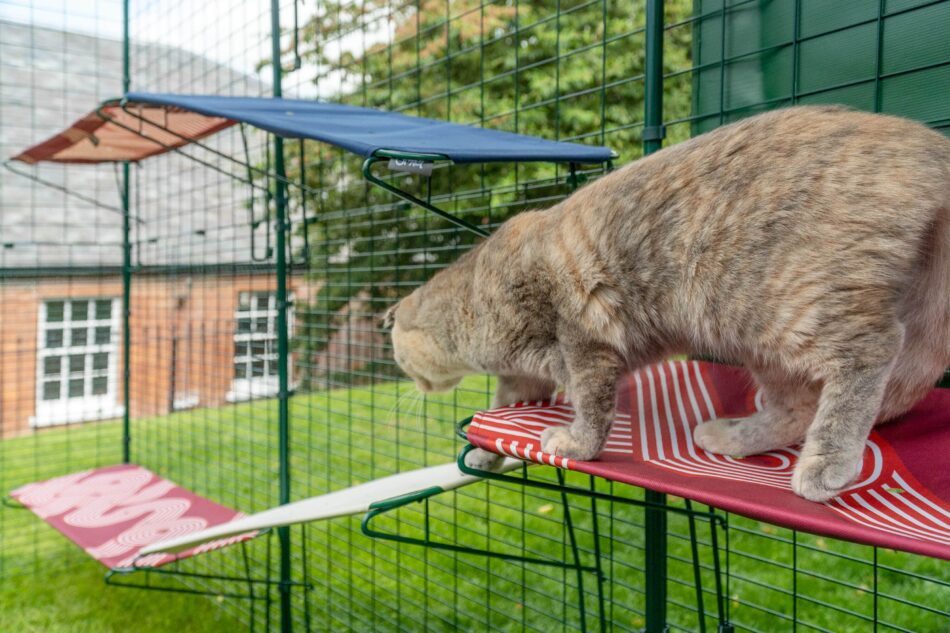
This entry was posted in Cats
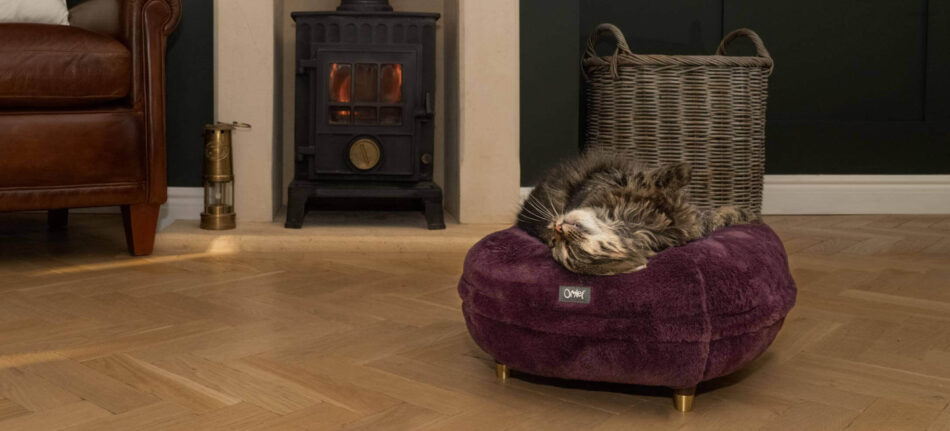
When it comes to sleep, cats are the experts in this field. Often with the ability to sleep anywhere and in any position, cats are known for their love of slumber. But why do cats sleep so much? And how many hours of sleep a day do they really need? We have uncovered all the information you need to better understand your feline’s forty winks and why they may just have the paw on the pulse of pertinent sleep.
Why do cats sleep so much?
When it comes to sleep with any animal, two-legged or four-legged, there are a variety of different explanations for why so much sleep is needed. For cats, the best way to understand their sleep is to understand their biology.
By nature, cats are predators and are hard-wired as stalkers of prey. In order to quickly pounce and catch their food, they require quick bursts of energy to react. As a result, their bodies naturally seek quick, and often short, bursts of sleep to recharge.
While most felines spend the majority of their day in a snoozy state, only 25% of that time is actual deep sleep. The other 75% of the time they are in just a lightly rested state, or what we refer to as a “cat nap”. How can you tell which sleep state your cat is in? Next time your furry friend is snoozing on their super dreamy Maya Donut cat bed, check for any twitching of their ears. If you see movement, that means they’re likely in a rested, but not deep sleep. You can take a cat out of the wild, but you cannot take the wild instinct out of the cat.
So while cats may seem to sleep a lot, they usually never get it all in one stretch. Instead, they naturally opt for short 30-100 minute snooze breaks where they can rest their mind and bodies until the next burst of energy.
How many hours do cats sleep?
On average, most adult cats will sleep anywhere from 13-16 hours a day, with some only catching 10 hours of zzzs and others logging a total of 20 hours. While age, health, and disposition are key factors in a cat’s sleep habits, any cat owner will tell you that most cats sleep throughout the day. And often the night, too.
Kitten sleep
As tiny feline furballs, kittens average more sleep than the average adult cat. Why so much slumber? Kittens, like babies, are growing and learning at an exponential rate in their early stages of life. With such a rapid intake of information, sleep is an essential part of their development to process and grow. On average, most kittens can sleep 16-20 hours a day and this is completely normal. Just know that with every kitty cat nap, a frenzy of furball play will follow.
Adult cat sleep
By the time your kitten has reached maturity, which is usually around 18 months, they will have established a more regular sleep schedule. Most adult cats can sleep anywhere between 12-20 hours a day with short and abbreviated naps all day long. In the wild, cats tend to sleep all day and hunt all night. However, as man has domesticated our furry felines, they have adapted and learned to adopt new sleep patterns. So while you may still have a cat that likes to play at night, most adult cats will split their sleeping equally between day and night.
Senior cats
Just like humans, as cats get older, their sleep tends to get longer. Their bodies and metabolism slow down, requiring less outbursts of energy. Depending on breed, older cats are considered “senior” when they reach about 12-14 years of age. By this stage in their life, they may be logging up to 20 hours of sleep in a 24-hour period. This is completely normal. If, however, you do notice your senior cat’s sleep behaviors – like discomfort or unusual movement while sleeping – change, then consult with your veterinarian to make sure there is nothing else going on.
Which cat breeds like to sleep the most?
If you are looking for a lazy lap lounger to binge Netflix with you all day, you’re in luck. While all cats like to sleep, there are some that relish in the sweetness of slumber more than others. Let’s take a look at which cat breeds like to sleep the most:
Ragdoll: If given the chance to play with catnip or relax into a cat nap, the Ragdoll cat breed would choose the latter every time. This easy-going professional napper is also super affectionate and can fall asleep in any position. In fact, they have been known to ‘go limp’ in your arms when you pick them up, hence how they received their name.
Maine Coon: Known as the “gentle giant”, Maine Coon cats are the ultimate cuddling cat companions. Despite being large and long, this breed loves a snuggle session better than most and is happy to keep you warm on your couch both day and night.
Persian: What has long hair and could sleep all day long? Persians. If sleeping were an Olympic sport, the Persian would win gold. This breed is known as the relaxation expert so if you are seeking a sleeping companion, look no further than the Persian.
Just remember that with these cat breeds, because they prefer sleep more than most, that having lots of playtimes and cat toys is essential. Yes, sleep is beneficial for their health, but too much of any one thing isn’t good, so be sure to keep them active when awake.
Impacts on a cat’s sleep and how to encourage better habits
Most domesticated animals will start to adopt the sleep/awake patterns of their owners over time. Cats are no exception. While they do sleep more than humans on any given day, they can be just as affected by external influences as we are. We have compiled a list of some factors that could impact your cat’s sleep and offered some ways to encourage a better sleeping environment.
The right cat bed
When it comes to finding a bed for your cat, choosing something they’d rather rest on than your own bed can seem like a mission impossible. An uncomfortable, unsupportive bed is a recipe for a restless night for both you and your cat who decides to curl up on your covers instead. This is where the Omlet product designers step in. Meet the Maya Donut cat bed – a cat bed so luxurious it feels like a warm hug with every snooze. With a supportive shape and deep filling, the bed provides first-class comfort for cats, with a calming effect for anxious felines. Made with a faux fur material, the super soft feel of the bed is irresistible for any four-legged friend. Plus, you’ll sleep easy too, knowing that your cat is nestled up in the bed of their dreams.
Light
Whether artificial or natural, too much light for a cat can be a bad thing. In the wild, cats will seek out covered den-like areas to catch some quick zzzs. That innate trait stays with them, even in domestication. So having a darker sleeping environment is crucial to your cat’s sleep.
Just like we humans can’t sleep with all the lights on or when the sun is at high noon, neither can our feline friends. So try and create a room or space in your house that your cat can retreat to in order to get their beloved slumber. The Omlet Maya indoor cat house is the perfect option as it provides your cat with the secluded sanctuary they desire. Plus, the Maya Donut cat bed fits in perfectly with the cat house, creating the perfect cozy getaway space.
Active owners
Monkey see, monkey do! Or in the case of your cats, feline see, feline do! Even though cats are solitary animals who can easily enjoy a solo life, they usually can’t help but be impacted by the lifestyle of their respective owners. Especially in the last few years as people have rearranged their work habits to include more time spent at home, this impact is felt fully by your feline friends.
Most cats can sleep anywhere, at any time. However, if you, their owner, are constantly moving about the house and making disruptive noises, your cat’s sleep will be impacted. So while you may not be able to change your habits, you can help adjust your cats by giving them more spots and places to seek solitude. Consider the Freestyle Indoor Cat Tree where you can customize the ultimate “active to sleep retreat” for your cat.
Change in diet
Have you ever had a big greasy meal for dinner only to find yourself in a restless night’s sleep later? Cats can feel the same way whenever their food is changed or adjusted. When we start to feel lazy or like we may be putting on some extra weight, we have a tendency to reduce the amount of food we eat. And all too often, pet parents will make the same mistake with their cats. They think that because their cat is sleeping all day, it certainly can’t be burning off all the food it ate. So perhaps a reduction in their amount of food is the right idea? Wrong!
A quick reduction in your cat’s food intake will quickly result in a negative impact on their sleep. Before making any changes to your cat’s diet, always first consult with your veterinarian. And no matter how much you feed them, make sure your cat has a clean and sturdy cat food bowl to eat and drink from.
Omlet and your cat’s sleep
Omlet knows the importance of a cat’s sleep, which is why we made products like the Maya Donut cat bed and Maya Indoor cat house. So, next time your cat is sprawled out on the sofa in yet another siesta, try to appreciate their ease of life. Grab a blanket, curl up next to them and enjoy a quick cat nap.
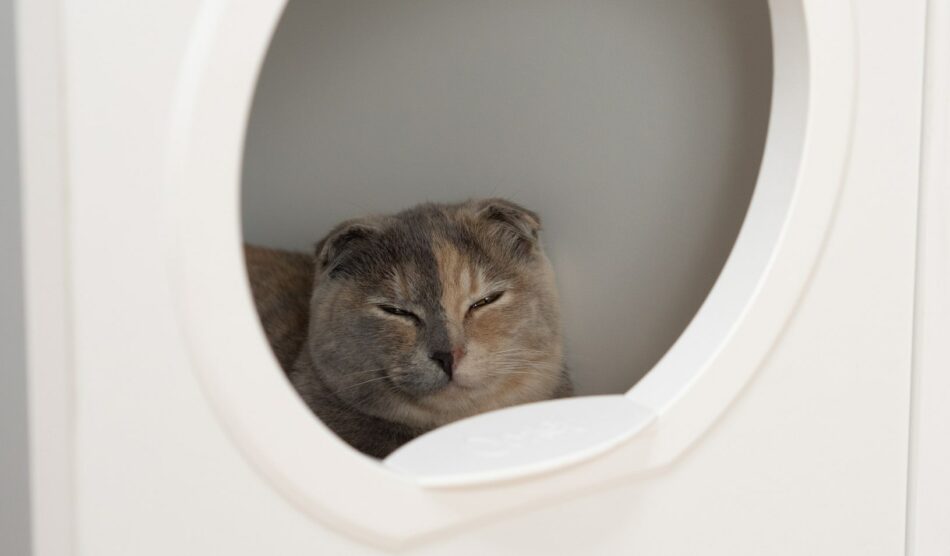

This entry was posted in Cats
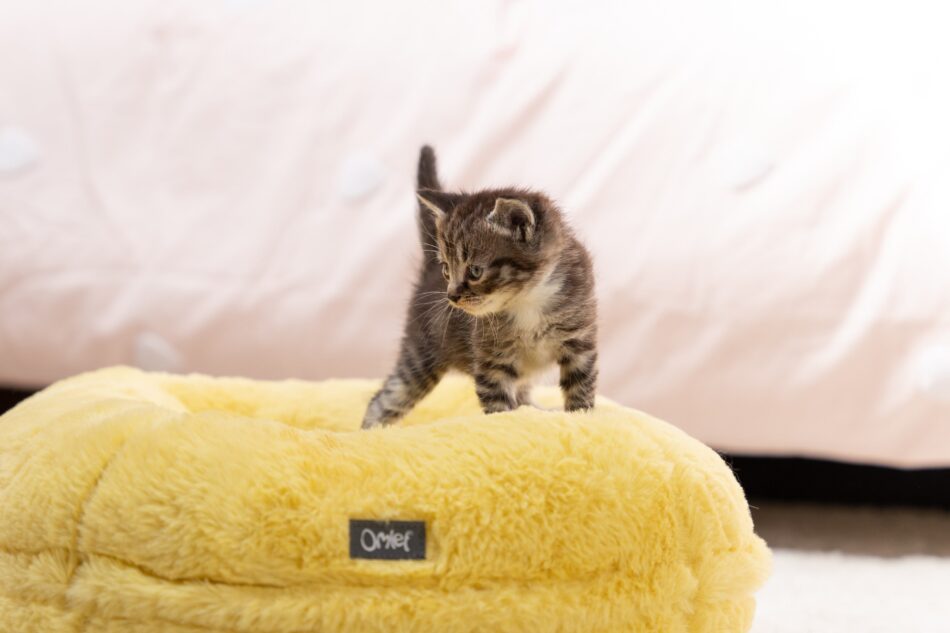
What has four paws, endless energy, and acts like a toddler? If you answered “a kitten”, you are correct!
Being a cat parent is a true joy! But have you ever raised a kitten? Do you know the different preparations and expectations that come with parenting a feline furball? We have sorted through the tips and tricks to provide you with the best knowledge on how to successfully raise a kitten!
Preparation
Kittens are born with their eyes still closed and an unregulated body temperature. Therefore, it’s important that they stay with their mother for at least the first 8 weeks of life to get their basic life needs met. When looking to bring a new kitten home, this allows you plenty of “prep” time to get everything set up in your home so your new kitty will adjust well!
The first thing you need to do is identify a room in your home that will be the designated “safe room” for your kitten. If you have ever raised a two year old human, you know all too well what life is like with a kitten – they get into EVERYTHING! The safe room should be somewhere that all potentially toxic items have been removed (i.e. plants, food, etc.), electrical cords have been put away, and unfamiliar dangers are eliminated. Once this room is set up you can start filling this space with all your kitten essentials!
New kitten checklist
Just like human babies, kittens require a lot of “stuff” in the early stages of life! Not only for their basic life needs, but for the development of their curiosity, personality, and engagement with others. Here are a few of the “must-have” items you need when raising a kitten:
- Food and water: Like babies, kittens require a specialized diet in the first few weeks of life – food that is formulated just for kittens and is highly digestible for their still developing bodies. The Omlet Maya Cat Bowl is a great item to have for their food and water as it is virtually untippable and environmentally safe to eat from!
- Litter box: Training a kitten to use a litter box early on will save you from unnecessary sprays later. Where you train your kitten to use the bathroom initially is where they will continue to go, so try and invest in a litter box option that can grow with your feline. The Omlet Maya Cat Litter Box is the prrr-fect option as it not only provides privacy, but doubles as a stylish piece of furniture as well!
- Indoor cat tree: Out in the wild, cats use trees for various reasons: to climb and check out their surroundings, to escape and feel safe, and to scratch their claws for comfort. Having an indoor cat tree for your kitten is not only essential for their innate understanding of life, but for their fun and happiness, too! The Freestyle Indoor Cat Tree is your one stop tree for all your kitten (and cat!) needs! Completely customizable with baskets and scratchers, this is the last cat tree you will ever need to buy!
- Toys: Kittens have a one-track mind in their early weeks of life: play, play, play! So the more toys you can have on hand to engage and entertain their playful minds, the better!
- Cat bed: All cats like a good cat nap – especially kittens who can log up to 20 hours of sleep in one day! And because most cats like to sleep in a curled up, nested position, finding a good cat bed is essential! The Omlet Maya Donut Cat Bed comes with a removable and washable cover, making it the ideal solution for your kitten to sleep and rest as they truly desire! You can even customize the color and feet to make it the perfect addition to your den!
Bringing kitten home
Now that you have your kitten “safe room” set up with all your kitten essentials, it’s time to bring your feline furball home! When it comes to raising a kitten, slow and steady wins the race! Let’s take a look at what you can expect over the first few months of life with your new kitten:
8-11 weeks of age: Most breeders will keep kittens with their moms until 8 weeks of age, so at the time you bring them to your home, they will be at least 2 months old. During these first few weeks together, your kitten will still be growing developmentally and acquiring new motor skills. So be sure to do lots of interactive play! This will help to build the bond between you and your kitten and help them to establish boundaries.
2 months – 4 months: Kittens experience exponential growth during this time of life! Have you ever heard of the “terrible twos”? That’s kind of what you can expect at this stage! At this age, kittens have approximately three times the amount of energy as an adult cat. And if your kitten is the only four-legged animal in your house, then they consider YOU their playmate! So expect to be playing A LOT with them to help you build a bond!
4 months – 6 months: By this point, your kitten has reached adolescence. This is the best time to get them spayed or neutered and begin regular vet visits for check-ups. Kittens start to become more territorial at this stage of life, so be on the lookout for any spraying and marking of items and areas.
Kittens + companions
Whether you are a single kitten household or a family full of four-legged friends, there are certain best practices to follow when introducing your new feline to others! We have explored the expectations of raising a kitten solo, but what if you already have other cats or dogs or kids at home?
Multiple kittens
Raising a kitten can be loads of work and copious amounts of fun! But raising two kittens? It’s double the love! The best time to introduce your new kitten to a companion is when that companion is also a kitten. When they are young, kittens have not yet established a sense of hierarchy, so getting to know and understand life with a friend who is the same age is a bonus for both felines! Make sure both kittens get equal amounts of attention and play and a lasting bond is sure to follow!
Kitten and dog
While nature may suggest that cats and dogs don’t get along, we disagree! With a little bit of patience and a lot of preparation, you can absolutely raise a kitten alongside a dog. The main thing to consider when raising these two very different animals together is that the introductions need to take time. On average, it can take anywhere from 4 weeks to 6 months before cats and dogs are comfortably cohabitating. The key to this relationship? Patience and persistence!
Kitten and children
Who doesn’t love a tiny furry feline? Most kids do! But when is the best time to get a kitten when you have kids at home? It’s important to consider the age of your kids when also considering a kitten. No child under the age of 12 should be given full responsibility of raising a kitten, so be sure there is an adult who can attend to the main care of the cat!

What to avoid
Happy kittens grow into happy cats and providing the right environment for their upbringing is an essential factor to their disposition. Let’s take a look at the do’s and don’ts of raising a kitten:
DO – Create a safe room and environment where they can feel comfortable and secure.
DON’T – Isolate your kitten by themselves. They need lots of attention and affection in the early stages of life to better adapt as affectionate adult cats!
DO – Feed your kitten specific food to their growing needs and body requirements.
DON’T – Give your kitten human food! Not only will this be potentially harmful to their digestive systems, but it will also establish harmful boundaries around human food later in life.
DO – Let your cat explore the outside world beyond the confines of your established “‘safe room”.
DON’T – Let your kitten or your cat go outside unsupervised! Domesticated animals do not have the same innate predatory instincts as wild animals and, as a result, could be in danger if left outside unattended. Consider an outdoor cat enclosure as the perfect option to let your kitten (or several cats!) explore the outside without worry of safety!
DO – Have lots of patience when raising a kitten!
DON’T – Expect too much, too soon! Just like babies, raising a kitten takes time and patience. And it will be a reward worth waiting for!
Kittens are tiny angels with whiskers! They may take some time and a lot of responsibility to raise, but the fruits of your labor will be immeasurable. With the right amount of love, patience, and preparation, they will grow into big angels with longer whiskers! Happy tails!
This entry was posted in Cats
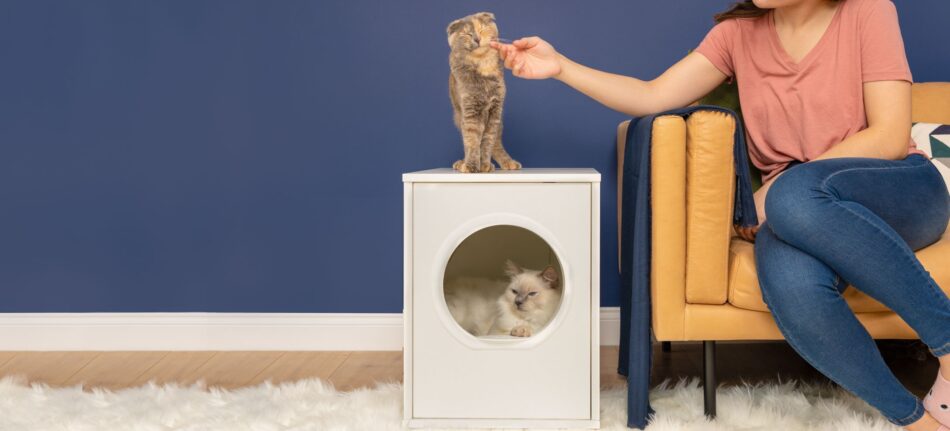
Unlike dogs, cats like to be by themselves. In fact, by nature, felines are solitary animals and are purr-fectly happy doing life solo! But what if you, the pet parent, like having lots of animals to love on? What if you are both a cat and a dog person? Just like human siblings, cats can learn to love a new companion!
When it comes to bringing new furry friends into your one cat house, it’s important to make sure you know the rules of engagement that will best suit every tail! With a little preparation and a lot of patience, you can have a friend for your feline that you will both love equally. Let’s explore the best ways to introduce your cat to a new pet!
Preparation
As any good cat owner knows, the best way to make your home feel comfortable to any feline is to “catify” it properly! Cats like to climb and scratch and have access to escape places so your home has to be “catified”, or transformed, to suit their needs. This means having indoor cat trees for exploration and a good cat house for solitary escape when needed.
Before bringing a new pet into your home, be sure you put all of your residents cat’s items in one location in the house so they have their own separate space. This includes all climbing structures and cat beds as well all toys, food, blankets, and even their litter box. Basically any item that is a scent soaker for your cat! This will allow you to have a “basecamp” for your cat as you slowly make introductions.
A new cat friend
Some people say that cats are like spoonfuls of ice cream – you can’t have just one! There are millions of homes around the globe with two or more cats living happily together, so you, too, can do the same! Here are a few tips to help make that initial meeting and lifetime together harmonious:
Tip 1: The number one rule to remember when introducing two cats is to not let them meet face to face right away! Cats are not only solitary beings, but territorial as well, and meeting by scent only at first will better help with adjustments. Set up a separate area of your home – a guest room, office, etc. – that will be initially dedicated as the “new cat’s” home. Put all of their climbing trees, food, water, toys and litter box inside this space so it is completely separate from your resident cat.
Tip 2: After 2-3 days of bringing your new feline home, switch the “basecamp” spaces that each cat is in. If your resident cat was staying in the guest bedroom and the new cat was in the office, swap their “stuff” from one room to the other and have them stay the next 2-3 days in the new room. This will allow both cats to “get to know each other” through their respective scents before they actually meet.
Tip 3: On average, it can take a full week or more to gradually ease into the introduction process. Once both cats have successfully sniffed one another’s scents, it’s time for the official meet and greet. We suggest putting up a gate to block space between the cats for the initial meeting. With the resident cat on one side of the gate and your new feline friend on the other, slowly allow them to meet. Be sure to have treats for each of them to reward and encourage good behavior and toys for them to play with! You can repeat this step several times over the course of a few days with the goal of getting the cats to eat their food on either side while not being too bothered by each other.
Tip 4: After several “meets” with a barrier between them, the goal is to make sure that neither your resident cat nor your new cat are showing any signs of aggression. This process could take a few weeks up to a few months depending on the disposition of each cat. Keep in mind that if your new feline friend is a kitten, this process can take a bit longer. Kittens have lots of energy and if your resident cat is older, they may respectively need more time to adjust!
Your patience and persistence will pay off! Now you can open up the space and allow for both cats to mingle together without restrictions! Congratulations – you are now a multiple cat parent!
A new dog friend
You know the saying, “they fight like cats and dogs”? We think this notion is a myth! While canines and felines are not naturally the best of friends, they can absolutely co-exist together in perfect harmony! If you own a cat and want to introduce a new dog to the mix, the steps to do so are not that different from introducing a new cat. Be sure to follow the previous tips and consider these as well:
- When you do a first face-to-face with your new dog and resident cat, make sure your cat is at the dog’s eye level. This will help level the playing, or size difference, field between the two animals!
- Have a family member or friend hold the cat while you hold the dog to ensure safety for both should either animal show aggression.
- Limit alone time together until you feel completely comfortable that both animals are able to coexist without issue.
- The goal in a cat and dog relationship is toleration – not necessarily affection. So if both animals ignore one another consider that a sign of success!

Signs of success
As with any sibling relationship, there will be growing pains and wins along the way! While there is no magic formula that will guarantee a successful loving relationship between your cat and their new friend, there are a few signs to look for!
Adult current cat + adult new cat
If both your resident cat and new cat are adults, their bond could be immediate or could take months. The best way to have a successful older cat relationship? Make sure you really know the demeanor of your current cat before deciding on which new cat to bring home. If your resident cat is a snuggler and lazy lap lounger, you want to try to make sure the new cat fits the same personality. Knowing their key behavior traits beforehand will better provide for success sooner. You will know the two are happy housemates when they can co-exist in the same space without showing any signs of aggression!
Adult current cat + kitten
Kittens are energy furballs in motion! If your resident cat is of adult age, they may take some more time to warm up to the idea of a younger playmate. It’s a natural order for felines to want to establish hierarchy with other cats, so don’t be surprised if your once docile cat starts to hiss and swat at the new kitty. This is normal at first and should be tolerated as long as no felines are hurt in the process! A successful cat and kitten relationship can be found when boundaries are established and both cats understand them.
Adult current cat + dog
It’s true! Cats and dogs can in fact be best friends! While this is more of an exception than a rule, we have uncovered above the necessary preparations to make this relationship work well! The most important thing to remember when having both a cat and a dog in the house is that separate spaces are a successful key to this relationship! Once you have spent the time to make sure they can be around one another without aggression, be sure to always separate them to their individual spaces when unattended. Both your cat and your dog will appreciate this!
Essential products
There are many ways to make a house a home and for felines, there are many products that make them feel at home, too! Here is a list of the essential “must have” cat products you need to have for both your current cat and new cat:
Cat tree
Cat Tree: Cats like to scratch – A LOT! So having a place where they can sink their claws into is essential – especially if you want to keep your couches scratch free! In addition, a cat tree affords your cat the ability to climb up high to escape the dog when it may become too annoying! The Omlet Freestyle Indoor Cat Tree is a great option as it is completely customizable! Available in 6 sizes with a variety of accessories to choose from, this cat tree can easily accommodate all of your felines!
Outdoor cat enclosure
If you have a backyard space, consider an outdoor cat enclosure that will allow your cat to enjoy the freedom of being in nature without concern of wandering off. Bonus – the Omlet Outdoor Catio can be used by multiple cats at once! Simply install a cat enclosure partition to allow both cats the same freedom to roam, but with independent spaces! And if you lack a backyard – don’t worry! Omlet’s Cat Balcony Enclosure provides the same fully secure and escape proof experience!
Cat beds
We have the saying “cat nap” for a reason – cats love a good snooze! When owning multiple cats, be sure you have a bed for every feline because they don’t like to share! The Maya Donut Elevated Cat Bed is a great option with its customizable fabrics and machine washable capabilities!
Litter box
The biggest difference between cats and dogs? Where they go to the bathroom! And just like cat beds, you need to have at least one litter box for each cat in your house. Since cats like privacy when they are using “the loo”, consider the Maya Cat Litter Box that doubles as a sleek piece of furniture while also providing privacy! This customizable litter box design also helps minimize smells and messes!
When it comes to owning more than one cat, the keys to success are simple: preparation, persistence, and patience! Your resident cat may not know that they want a new sibling right away, but with a little bit of time and a whole lot of love, they will likely be cuddling with their new companion in no time! Happy tails!

This entry was posted in Cats
Your feline may be furtastic in every way, but can it jump the length of a giraffe’s neck? Or purr as loud as a vacuum cleaner? Earlier this month we explored the extraordinary canines who are world record dogs and now it’s the kitty’s turn to show off. Prepare to be wowed by these incredible cats and the Guinness World Records they hold.
Longest cat
Up first is Mymains Stewart Gilligan who holds the Guinness World Record as the longest cat. Coming in at a lengthy 48 in, this Maine Coon cat, who you can call Stewie for short, was as long as most 7 year old children. Hailing from Reno, NV, Stewie was a certified therapy animal whose owner, Robin Hendrickson, took her 4ft friend everywhere.
Taking care of all that hair on a cat this length will require proper health and hygiene. And if your feline is as long as Stewie, you may need a bigger bathtub!
Shortest cat
From longest to shortest, the world record holder for being purrfectly pint size is one of the world’s smallest cat breeds. Lilieput is a female munchkin cat from Napa, CA who stands 5.25 in. tall from floor to shoulder! To better understand this small stature, a US dollar bill is 6 in. long so Lilieput was shorter than that!
Christel Young, a professional pet sitter, adopted this pocket-sized puss as a stray. Initially, she said people referred to Lilieput as a “weirdo” because of her appearance. However, after receiving the Guinness World Record in 2013, those comments turned from cruel to kind. Who doesn’t love a tiny kitty?
Longest jump by a cat
Most cats land on their feet when they jump, but what if they are jumping the length of a king-sized mattress? The Guinness World Record for the longest jump by a cat was awarded in 2018 to Waffle the Warrior Cat with a whopping 7ft jump! And here’s the kicker – Waffle was 10 years old when he made this leap into the record books!
If you want your feline to beat this long feat, you will need to get a good indoor climbing cat tree for added practice. You can customize the Omlet cat tower to over 14ft tall so maybe your kitty can give Waffle a run for his catnip!
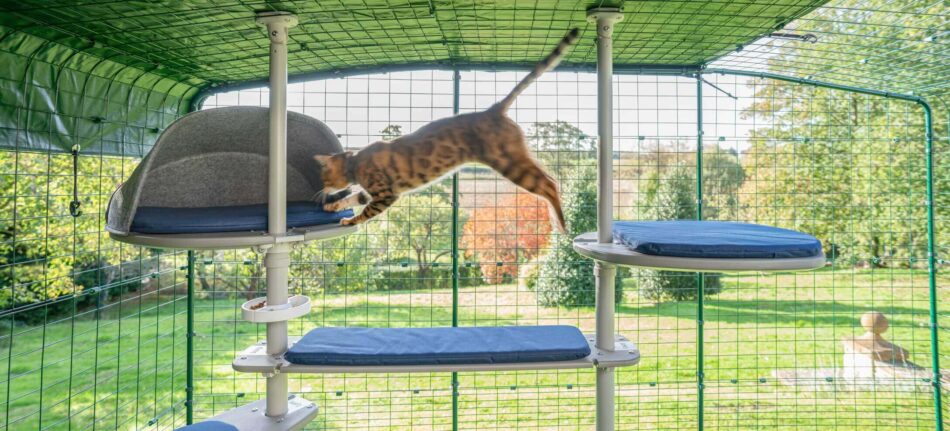
Cat with loudest purr
In 2015, Merlin, a rescue kitty from the United Kingdom, received the world record for the loudest purr – 67.8 decibels loud! To better understand in comparison, this mega-loud mouser can purr at the same level as a washing machine or vacuum cleaner. Owner Tracy Westwood said people often ask her “what’s that noise in the background?” when she is on the phone – only to find out it’s just her thundering tabby!
Most toes on a cat
The average cat has a total of 18 toes – 5 on each front paw, and 4 on both back paws. If you have visited Key West, you may have met some of the famous Hemingway cats who are unique with 6 toes on each paw.
But the world record holder for the most toes on a cat belongs to a 28 fingered – or toed – feline from Canada. Jake, a ginger tabby cat, was awarded this toe-tally pawsome world record in 2002 for having 7 toes on each paw! High seven, Jake!
Oldest cat ever to live
The Guinness World Record for the oldest cat ever to live goes to Creme Puff, a tabby cat from Texas. Born in 1967, this world record cat lived to be 38 years and 3 days old before passing away in 2005. That’s 168 years in human equivalence!
Owner, Jake Perry, said he kept his mature mouser healthy for so long by feeding her a diet of dry cat food, broccoli, eggs, and an eyedropper of red wine every two days! While this supposedly worked for Creme Puff, we aren’t surprised to hear that this type of diet has no veterinary backing. AKA – don’t try this at home, kids!
Longest cat whiskers
We know that whiskers play many important roles in a feline’s life, but does their length matter? For Missi the Maine Coon cat from Finland that answer is “yes”! This kitty not only holds the record for the longest cat whiskers at 7.5 in. long, but might also have the longest name, too! Missi is short for Fullmoon’s Miss American Pie – a suitable name for a notable record indeed!
Most tricks by a cat in one minute
If you thought teaching tricks to pets was reserved only for dogs, think again! In 2017, Didga the talented tabby set this world record by successfully completing 24 tricks with her owner, Robert Dollwet, in just 60 seconds.
This purr-fect kitty can not only sit, shake and rollover on command, but she can also jump over a stick while riding on a skateboard! Hailing from Australia, Didga (short for Didgeridoo), apparently loves to perform these impressive tricks for her favourite treat – raw kangaroo mince.
Longest domestic cat tail
Cygnus, the silver Maine Coon cat from Farmington Hills, MI, took home the Guinness World Record for longest tail on a domestic cat in 2017. Measuring a staggering 17.58 in. long, his tail was actually longer than his body length! Can you imagine walking around with a tail longer than you?
As rare as it is to have one cat world record holder, Cygnus shared his home, and the spotlight, with another record breaker! That’s right, owners Will and Lauren Powers, also owned Arcturus – the tallest cat record holder who measured 20 in. tall.
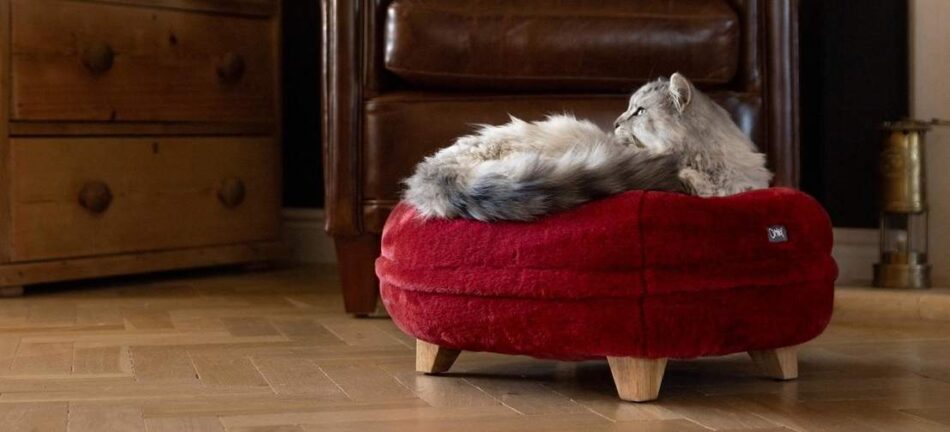
Largest domestic cat in the world
We saved the biggest, or best, for last! Ludo, a Maine Coon cat from the United Kingdom, holds the record for the largest domestic cat in the world with his 3ft 10.6 in length and 34 lb. body weight! To put that in perspective, Ludo weighed as much as a standard cinder block!
Owner Kelsey Gill knew early on that her favourite feline was pretty fantastic when he weighed in at 20.5 lbs before his first birthday! If you think your pretty kitty is a contender for this type of record, then a large outdoor cat enclosure would be perfect for them. This robust kitty play area is super spacious for cats of all sizes to roam easily!
We hope you enjoyed reading about these furtastic felines and their impressive Guinness World Records! For more information about cats of all kinds, be sure to check out the Omlet Cat Guide.
This entry was posted in Cats
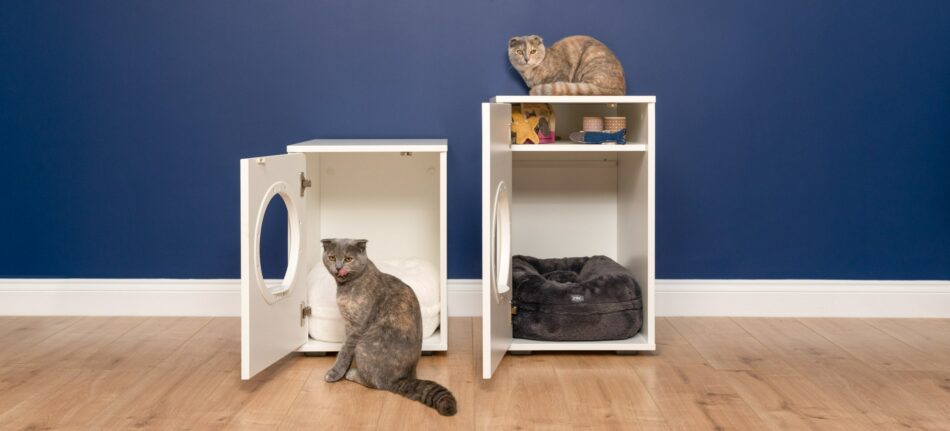
Does your furry feline peacefully snuggle up next to you in bed or insist on sleeping on your pillow? Or do you have a designated spot for your cat to claim as their own, yet they still prefer the back of your sofa? There are pros and cons to sharing your bed with your cat, and even though a bit of bed-hopping might be fun, having your own place to rest your sleepy head can’t be a bad thing. In this article, we’ll explore some kitty-approved places and find out where to put a cat’s bed.
Your cat’s perfect bed
The Maya Donut cat bed offers the perfect place for your cat to relax, and with a plush, faux fur finish, it’s completely irresistible. Plus, its easy-to-clean removable cover means a hygienic home for you and a clean sheet feeling for your cat. It comes in a variety of beautiful colours to suit any boudoir, too. Choose to have it without feet so you can place it inside your Maya Indoor cat house – a modern and stylish piece of furniture that can be placed anywhere in the home. The cat house acts as a sheltered and cosy spot so your cat can snuggle up and have a peaceful snooze away from the hustle and bustle of a busy home.
Likewise, a few felines really like to rest high up, so for the more intrepid explorers, you may find your cat has more of a head for heights and likes to be well out of the way and off the ground. In this case, you can accommodate this personality with an incredibly versatile Freestyle floor to the ceiling cat tree. As a customisable piece, you can add whatever you want to make this a fun entertainment and napping zone all in the comfort of your own home.
Where to put a cat’s bed
Resting is a fundamental part of a feline’s life and they give plenty of time to it. Cats ordinarily pick their most loved snoozing spot(s) themselves and it can be challenging to encourage them to choose somewhere else. To expand the possibilities of your feline utilising the bed you have picked, you can at least ensure that it is set in a peaceful spot, away from any drafts. A warm spot, close to a radiator or in the sun, is typically great and should get the seal of approval.
Choosing to have your cat’s bed in a specific spot not only provides them with security, but also gives you peace of mind knowing that they are comfortable, and hopefully where they should be. That’s not to say that the odd sleepover in your bed won’t happen though!
So, where do you put a cat’s bed that ticks the boxes of these very selective customers?
Here are a couple of suggestions, recommended by cats for humans:
- On your bed (with or without you in it)
- On the window sill, preferably south-facing
- In the utility room when the tumble dryer is on
- In the laundry cupboard on nice warm towels
- Curled up on my snuggly Donut cat bed
- Occasionally on your laptop
How much sleep does a cat need?
How long a cat sleeps and how often will depend on the age and personality of the cat. They are renowned for having mid-morning or afternoon siestas or it may seem as though they just sleep all day. Got a nice warm spot by the window? Then you’ll most likely find your cat there. Warmth and quiet are key to blissful nap time. Cats on average spend 12-16 hours per day snoozing, so that spot has to be right. Most of us envy cats who always seem to find the most comfortable place in the house and can sleep most of the day, and while we’re working or doing chores our cats always find time to enjoy a peaceful slumber. Cats can grow irritable and restless if they don’t get enough sleep (a bit like their pet parents). This could be because their bed isn’t in the right place and they are not comfortable.
Sharing your space
Occasionally sharing your bed with your favourite snuggle puss is no crime! In fact, most cat owners will have done this once or twice. Cats definitely benefit from being close to their pet parent and the feeling is mutual. It secures a bond and provides companionship.
Most cat owners know that cats are more active at night, even though they love to snuggle up to you to start with. Once they’ve had enough sleep there is always a possibility that they will pounce when your foot twitches or will come and plonk themselves on your pillow right next to your head. Even though it’s adorable, it can lead to a sleepless night (for you).
Creating an area in your bedroom for your cat could be an option, so that if they do become a little more active or start fidgeting they can always relocate themselves to their luxury cat bed that’s so soft you’ll want to curl up on it yourself – ideal for the pampered puss.
Where not to put a cat bed
A cat will not be very forgiving if you place its bed in a cold or damp spot. You should also make sure that it’s away from potentially drafty windows or a particularly noisy spot. For example, if your living room or kitchen faces a high-traffic zone, then this will not be favourable to your kitty and they will most likely seek out somewhere more quiet to rest.
Don’t shut them away
You may have a house full of pets, children or antique furniture in which case you might be tempted to shut away your cat at night. This isn’t recommended, given that they are most active at night, this is valuable playtime for them. It doesn’t mean they should roam the house completely rogue, but allowing them some space to explore is important to their development and ultimately their happiness.
Omlet and your cat’s bed
Providing your cat with their own space is key to stability, space and a routine that your cat is happy with. Having favourite napping spots is perfectly okay and your cat will undoubtedly choose their own whether you like it or not, but knowing they can call a place a home of their own with the Maya Donut cat bed and Maya indoor cat house will make them perfectly happy and adjusted. A stable home environment is paramount to your cat’s happiness, you can read one of our recent blogs Why do cats run away? which outlines the importance of a peaceful and secure home environment.
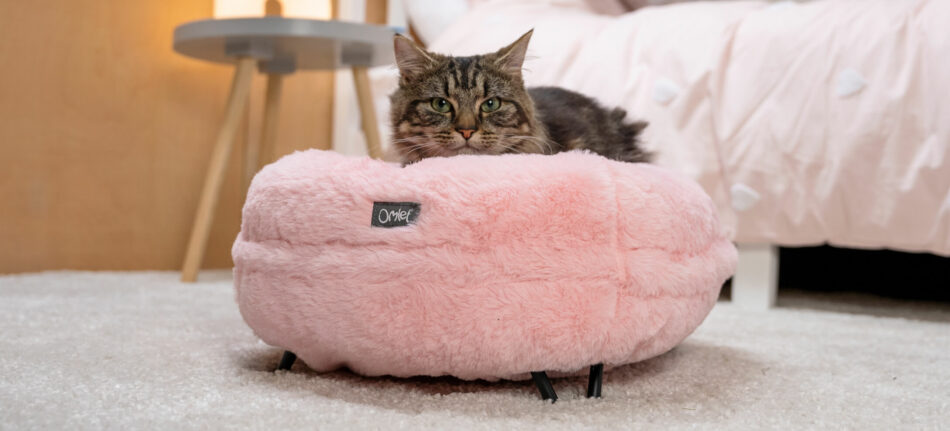
This entry was posted in Cats
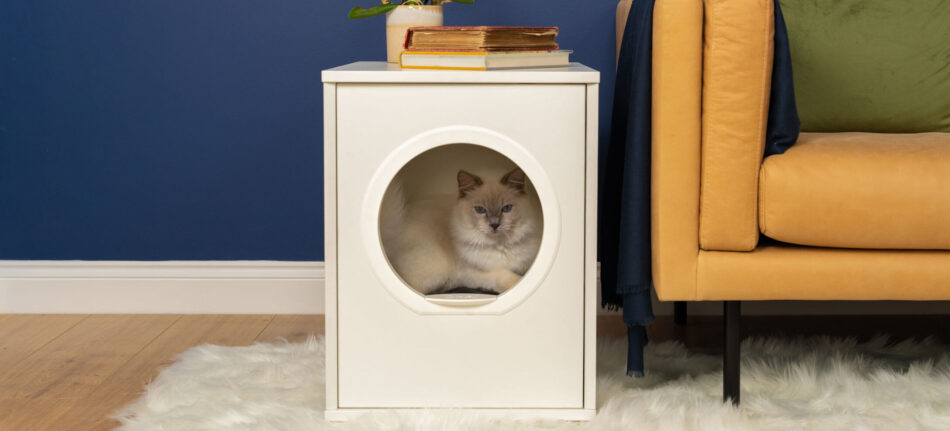
Whether your cat is moving with you to a new house or you’re welcoming a new cat into your life, a new home can be stressful and confusing for our feline friends. The first few days are especially trying, and it’s important that you as an owner do everything you can to make the move as smooth as possible for your pet. Read on to find out some top tips for moving with cats.
Moving to a new place with a cat – before the move
If you are moving with a cat, try to keep the cat’s routine as normal as possible in the days leading up to the move. Very anxious and timid cats will benefit from familiarizing themselves with cardboard boxes around the house before you start packing your belongings.
In the new house (or your current home if you’re rescuing a cat), prepare a room somewhere where you can keep your cat when you arrive. This should ideally be a spare room or a bathroom away from the hustle and bustle of the home. Cats will naturally think a new house is scary and smells unfamiliar, so giving them a smaller space to get familiarized with to start with can be less difficult.
Give your cat places to hide in the room, as well as a snug spot to relax, maybe with something they already feel comfortable with, like their super comfy donut cat bed or a blanket from the rescue center. Also prepare a cat litter box, bowls with food and water, and some toys.
A Freestyle cat scratching tree that is tall and rigid will also help your cat let off some steam and allow them to leave familiar scents from glands in their paws, which will help them keep calm.
If possible, prepare this room with everything your cat needs before bringing them home.
During the move
The most important thing when getting a cat to settle in a new environment is to have patience and always let your cat make the first move when it comes to approaching new things, or new people. Most cats love feeling in control, and by pulling them out of the cat carrier or picking them up for a cuddle you could be adding to your cat’s stress.
Be aware that it might be a few weeks, or even months, before your cat feels comfortable in their new home. It takes them time to get used to new surroundings, not to mention other cats or children they’ve never encountered before.
If possible, it’s good to give your pets something familiar that makes them feel safe. If you’re adopting a cat, ask the adoption center if they have a blanket or toy your new addition has been using, or if you’re moving house with your resident cat, unpack their things first. Don’t change the food you’re giving them, give them a new litter tray or treat them to a new bed just yet.
How to introduce cat to new home
Make sure the space where your cat is allowed to be is completely cat proof. This might, to start with, just be one room, but if you’re letting your feline friend explore the whole house, keep all doors and windows closed, and check potential cat flaps or even chimneys before you invite your cat in. Give everyone around on moving day careful instructions or put a sign on doors to inform them where the cat is. The new home will seem like an unsafe space for your pet, and their instinct will most likely be to escape.
Once you have set up a room or an area for your cat to initially settle into, carry the cat into the room and open the door to the cat carrier. Sit back and see what they are doing, but never force them to come out or pick them up, let them explore in their own time. You can sit in the room, or you can leave for a bit and come back later.
When you have seen that your cat is comfortable in their room you can open the door and allow them to come into the rest of the house whenever they feel ready. Cats are naturally inquisitive, so they will want to explore their new surroundings.
If you have other animals or pets in the house that your new cat has not met before, make careful introductions i.e. initially using a barrier, keeping a distance. You should try to space out any stressful events to not overwhelm your cat.
It’s normal for a new cat, or a cat in a new home, to not have much of an appetite or to cry during the first few nights. Unless you think it might be detrimental to your cat’s health, or that they are in danger, leave them to it. Most cats will stop this behavior after a couple of days.
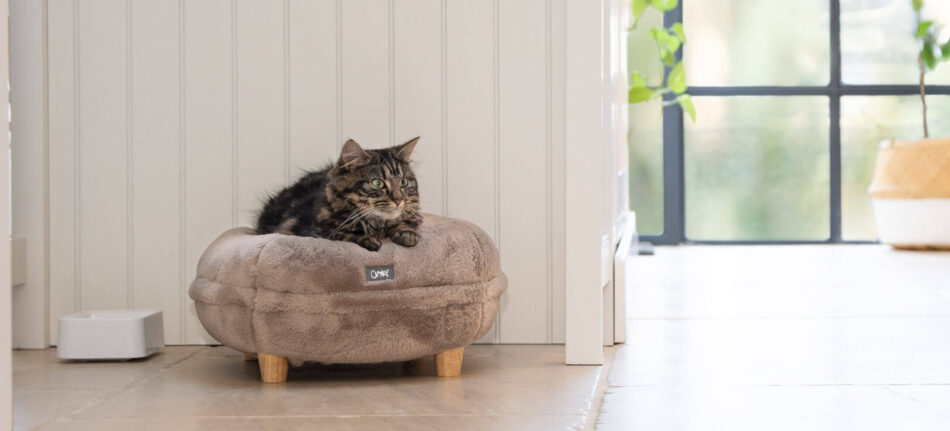
Transporting your cat to a new home
Make sure you have a good pet carrier that is big enough for your cat. If you can, it’s a good idea to get your cat used to car rides before the journey to a new home, but that is obviously more difficult if you’re picking up a rescue cat.
Put some soft bedding in the carrier and secure it in the trunk or with a seat belt inside the car. It’s important that it’s safe and doesn’t move around, as that will be very stressful for your cat. Regulate the temperature in the car so it’s cool but not cold.
Keep the journey as short as possible; don’t make any unnecessary detours or make stops you don’t have to make. If you do need to stop, it’s often best not to let the cat out of the carrier, as there is a risk they will escape. However, never leave your cat unattended in the car. It can quickly get dangerously hot, fast.
Moving a long distance with cats
If the journey is so long that you will need to stop and allow your cat to go to the toilet or eat and drink, it’s important you find a place where it’s safe to do so. Consider keeping your cat on a lead, or only let them out in a confined space. If you’re travelling really far you might want to sedate your cat to make the journey less stressful for all. Speak to your vet to see if this is an option.
When to let your cat outside
If you have a cat that normally spends a lot of time outdoors, you might want to let them out as soon as possible and give them their freedom back, but it’s generally good to keep a cat indoors for at least a few weeks. Moving is one of the most common reasons cats disappear, be it because they don’t feel safe in their new house or that they get lost, so be careful. You can read more about this in our previous blog post Why Do Cats Run Away?
Moving house with an outdoor cat
While keeping outdoor cats indoors, make sure they have plenty of stimulation and exercise opportunities.
Once you think your cat is ready to go outside, one thing you can do in preparation is to sprinkle a bit of used litter around the perimeter of the yard. This will make the outside space smell familiar to your cat, and other cats in the neighborhood will be warned that there is a new cat on the block.
The first times you let your cat out, make it short, and keep an eye on them. Call them back after a few minutes, and gradually extend the time they spend in and around the yard. It’s best to stay with them to reassure them that everything is fine, and leave the door or cat flap open so they can return into the house if something scares them.
If you have moved somewhere that doesn’t allow your cat to roam as freely as they have previously done, be it due to traffic, wildlife or neighbors, you might want to consider investing in an Outdoor Cat Run. Omlet’s catios lets your cat feel the wind in their fur in complete safety, and they can keep your cat healthy and fit without the worry of them running away or getting hurt. There is also the option of a Cat Balcony Enclosure if you live in an apartment.
Moving house with your cat
While lots of these tips apply to a new cat as well as a long term pet who is moving with you, there are some specific things that could help a current cat settle in.
As your cat has been living with you, there are things that will be easier than bringing home a new cat. Maybe they have a Maya Indoor Cat House or Memory Foam Bolster Cat Bed where they can go for some quiet time and that will immediately make them feel at home. If you want to introduce your cat to a cat house, this might be a good time, as they will be searching for a safe space to retreat to. You can read more about this in our previous blog How to Get a Cat to Use a Cat House.
Depending on their personality, you will probably want to let them out of their initial introduction room quite quickly. They are used to being around you and your family and keeping them separate can be more stressful. But again, wait for them to make the move.
One thing to help your cat adjust can be to take a piece of cloth and rub it gently around your cat’s neck and face to pick up their scent. You can then wipe this cloth on furniture in the house at cat height to make the new territory seem more familiar. Feliway products or a pheromone diffuser can also be good options.
Remember to update the address on their collar and change their microchip information on any database.
If you haven’t moved far, there is always the worry that your cat may disappear in search of their old home. Sometimes the new owners will provide food and leave out water bowls for the unexpected visitor, so, if possible, ask the new residents to let you know if your cat shows up. To avoid these trips down memory lane, keep your cat indoors for the first few weeks after the move. That won’t necessarily make them forget their old home, but should get them used to their new one, and hopefully realize that’s where they belong.
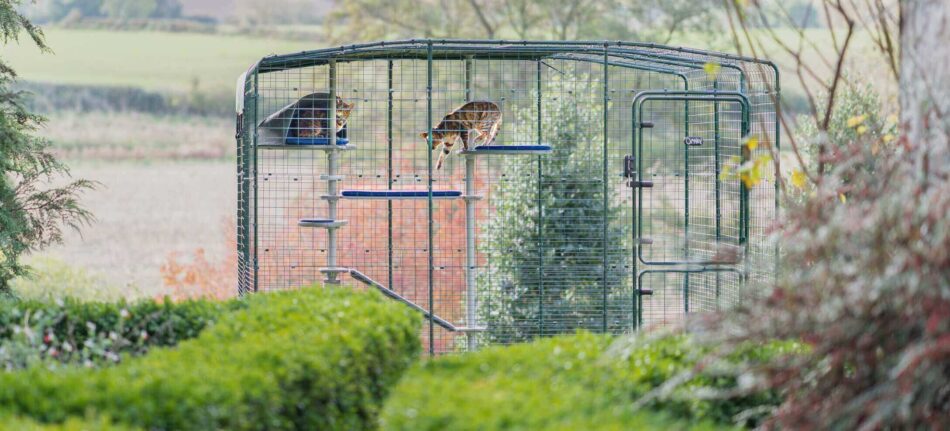
Moving with multiple cats
If you live in a multi-cat household, then this can inevitably make things a little bit complicated, but with the right preparations, the move can be made as stress free as possible! The process of moving itself isn’t all too different, but you will have to consider the needs of more than just one animal. Take a read of our How to Create Peace in a Multi Cat Household blog for some advice on creating a better dynamic between your cats, which will help in making the transition easier when the time comes.
Conclusion
A move is a very exciting event for both cats and humans, especially for those who are moving from a shelter to their forever home. However, most animals are creatures of habit, and many cats find a new house a very scary thing. To make the move a bit more comfortable, shop Omlet Cat Products to help you find everything your purry pal needs to settle into their new home. Make sure you prepare yourself for the next few days, or weeks, to be a bit tiring. And with these tips for moving with a cat, it will, of course, be worth it in the end!
This entry was posted in Cats

Common allergies in cats and dogs have been identified as 3 main allergy groups, which we explore in this article. Some common allergies are seasonal, and others can creep up throughout the year. Understanding the common allergies in cats and dogs will make being a pet owner easier as you know what to look out for and how to handle it. Allergies can be treated quite easily, but there are a few symptoms or warning signs that we can look out for to make sure that our cats and dogs are healthy and happy.
Persistent seasonal allergies such as the dreaded hay fever kicks in for many of us humans, but we know that we are not alone in this seasonal battle of the bugs as our beloved pets can suffer too. We exhaust alternative medications, home remedies and whatever we can lay our hands on to try and keep these pesky allergies at bay!
Despite doing our absolute best to ensure our cats and dogs are spoiled and looked after, sometimes we cannot always spot the potential threats of allergies or illness.
Allergies in cats and dogs fit into 3 main groups. These groups make it easier to be able to narrow down and identify the cause and then the form of treatment that is required. Whilst you may be able to “self-diagnose”, (we all like to play doctor or vet with a quick google search), it is always recommended to check with your vet before attempting any medicated treatments yourself. However, a little research and a general understanding of what you could expect as a pet owner are perfectly normal.
Common Allergy Groups in Cats and Dogs
1. Flea Allergy
This is probably the most common allergy and one that most pet parents are aware of. Cats and dogs will react to the toxins in the saliva following a flea bite, which will result in a reaction on the skin.
Cats will over groom to the point where it’s very noticeable and the skin develops crusts all over the body, known as miliary dermatitis. Dogs tend to nibble and scratch at the affected areas and the skin will develop little red spots.
2. Food Allergy
Food allergies don’t necessarily show up immediately, they could manifest from eating the same food over a long period of time. It is a reaction to a specific protein or chemical in the food, which then appears on the skin. Common proteins which can cause allergies for both cats and dogs are chicken, fish, gluten and egg.
A common symptom of food allergies in cats will be persistent scratching around the head and neck. Symptoms in dogs are not as easy to identify but generally if scratching is more regular and your dog’s skin seems more irritated then it could be a sign of a food allergy.
3. Atopic Dermatitis
These are allergies caused by the environment, similar to hay fever or asthma in humans. They can be seasonal like an allergy to pollen or all year round, for example dust mites. With dermatitis, the skin will be visibly irritated and affected with symptoms including the following:
- Constant scratching in a particular area
- Flaky skin
- Red or irritated skin
- Over licking
- Chewing
- Fur loss
- Patchy skin
- Skin rashes or spots

Should my pet see a dermatologist?
If you think your pet is suffering from an allergy with any of the symptoms mentioned, you will notice that the skin is affected. A dermatologist will try to recognize the cause of the skin irritation by discussing your pet’s history, for example diet, home life and behavior. Once they are able to identify the correct allergy group, they will be able to perform certain tests to pinpoint the exact cause and recommend any treatment or ways you can help.
Seasonal Common Allergies in Dogs
Seasonal allergies can affect your canine friends in very similar ways to humans. They could be affected by environmental allergens like dust mites, fleas, mold and pollens from grasses, trees, weeds, and flowers. They will not hide their discomfort and will most likely obsessively lick or scratch one particular area. Pay close attention to their bellies, paws, armpit, ears and face. During the seasons of irritation, keep your home as clean as possible and free of mites and pollen. The Topology Dog Bed provides a simple and stylish way to keep your doggy comfortable all year round with easy to clean removable and washable covers.
Seasonal Common Allergies in Cats
Cat allergies are not as common as they are for dogs, though some will display irritation from pollen or bites from fleas. If your cat sneezes a lot then it could have an allergy to pollens. As with dogs, it’s important to make sure their bed is kept clean. A good alternative is the luxury Maya Donut Cat Bed, which has a removable cover that can be washed in the machine.
Respiratory Allergies
Respiratory allergies are far less common in cats and dogs, but they can suffer from them. Symptoms are similar to those of a cold, including watery eyes, runny nose, coughs and yes, even sneezes! Some respiratory allergens could develop into asthma. This could occur from being in a smoky environment, building debris, chemicals or certain cleaning products or pollution.
Pets, like humans, benefit from fresh air, so taking dogs for regular long walks will always be good for them (and you). While you may want to take your cat for a walk, maybe it’s time to consider an Outdoor Catio, which will not only provide a safe space for your feline, but it will also provide them with plenty of space to play and explore and generally keep fit!
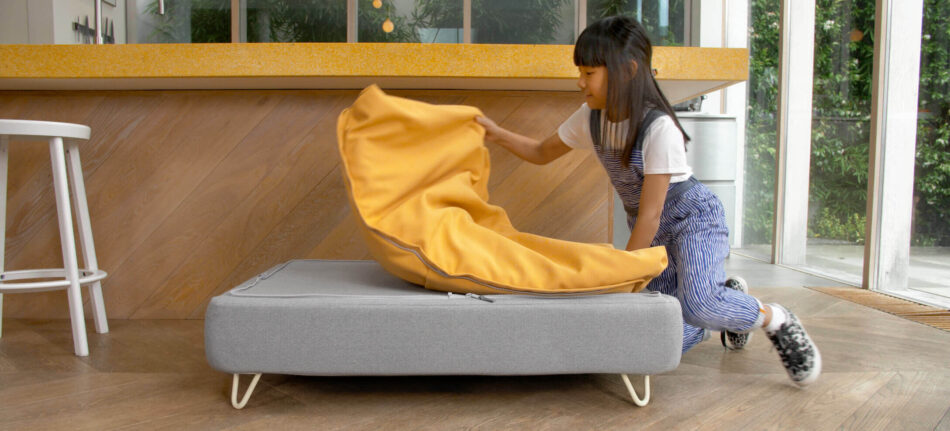
Conclusion
Being a pet parent comes with worries, but also plenty of love, laughter and snuggles along the way. Medically treating your cat or dog can be incredibly difficult to do because you don’t want to be the one that causes them any discomfort or pain, but sadly sometimes it is part of the job description and absolutely necessary to ensure they live a long and healthy life.
If you do suspect that your pet is suffering from any allergies, it is important to talk to your vet and run any concerns you have by them. Most allergies can be treated easily with medication, a change of diet or simple TLC. When dealing with allergies it is important to keep your cats and dogs home clean and you may need to adapt or change your routine to suit their needs.
This entry was posted in Cats
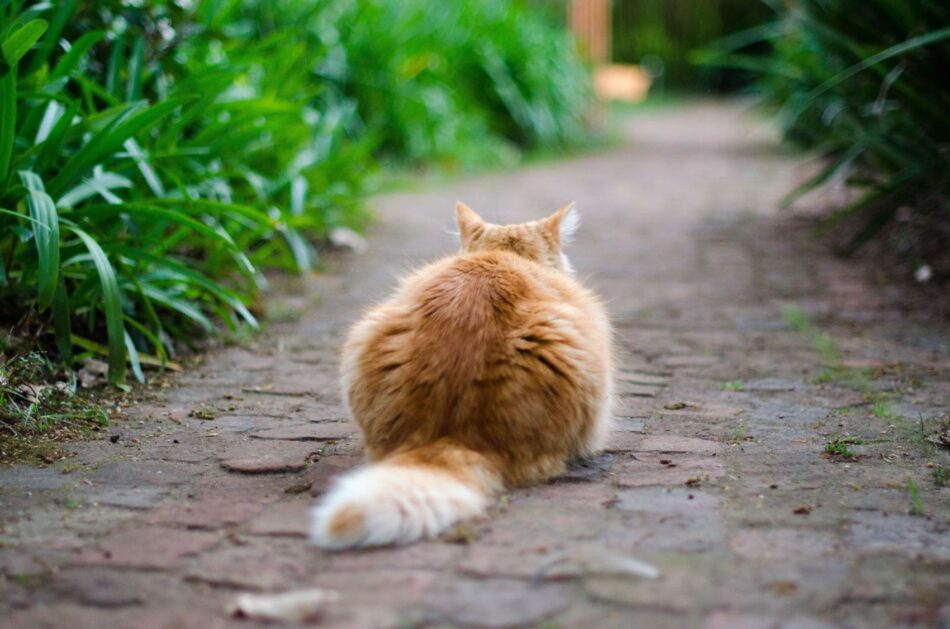
If your feline friend has turned your life into a frenzy and ran away before then you’re not alone. Cats are notoriously territorial, highly organized and routine-based, and are creatures of comfort and security. This does however not mean that they won’t abandon their home comforts if they feel the need for adventure or become distressed due to changes in their home environment. What are the main causes for our cats to run and turn curiosity into concern?
Possible Reasons why Cats go Missing and Don’t Come Back
Cats don’t just run away from home without a good reason. Indoor cats might be less likely to run because being outdoors isn’t something they are used to. Unfortunately, if something causes them to go outside and they get scared they could run out of fear and confusion. Outdoor cats might already be familiar with the perimeters of their homes, though there are many reasons why they too could run away. Here we look into various reasons why this could happen and what we can do about it if it does, so that our domesticated cats stay safe!
Your Cat was Scared
A cat’s disappearance can also be linked to fear. Indoor cats will have less access to the outdoors mostly for safety reasons or lack of outdoor space. They can be scared by loud noises, an unwelcomed visitor, for example a neighbor’s dog or something unfamiliar to them, and it doesn’t take long for your purrfectly happy pussycat to turn into a scaredy-cat. They certainly enjoy a peaceful environment and can often become quite disgruntled when that peace is disturbed. If their home life has become unsettled due to divorce, children leaving home or moving house their impulse could be to escape what may seem like a dangerous environment.
They’re in Season (or looking for a cat that is!)
This is something to watch out for, especially when female cats are in heat. When unneutered male cats get a whiff of a reproductive female there’s little you can do to distract him! It is not uncommon for cats to follow their mating instinct and they could disappear for days during this mating season.
As an owner of a female cat, it may be a good idea to keep them in during this time to avoid this dilemma and a few worried cat owners. Otherwise, ensure that your cats are neutered, which will diminish this instinct.
They were Stressed
As we have looked at some of the common, perhaps less threatening, causes for cats to run away, it is important to address the more serious reasons, which can be down to changes to the home environment and the stress that this can cause to our pets in general.
Cats are independent and can often be quite aloof and lead us to believe that they are pretty resilient, but this is not at all the case. They crave the security of home life, and while they’re not as dependent on us as dogs are, they love their human families and are very protective of them. As we spend so much time with our pets, they develop possibly more human characteristics than we realize. When our lives become unsettled, so do theirs. Take the time to explore cats and stress, why it happens and how to spot it.
Cats do suffer from separation anxiety, which may be more apparent as we emerged out of various lockdowns and headed back to work. If the home routine changes, cats will notice and can often become very distressed. This could lead to some more challenging behaviors, however, running away is unfortunately also very common as a result of stressed home life.
They’re Cheating on You
If you’ve noticed that your cat has put on a little weight, it’s not unlikely that an overly friendly neighbor is feeding them. Cats absolutely love being spoiled and they can be very sneaky and often get what they want. It’s unlikely that anyone will just allow a cat to be a permanent resident of their home without checking if they belong to anyone, but it’s best to be on the lookout. If you become aware that this in fact is happening, just have a polite word with the person(s) in question and stay one step ahead of your greedy pussycat.
You Didn’t have an Outdoor Catio
Allowing space for your cat to challenge itself and play is really important. At Omlet we have developed our Omlet Catio range, which provides a safe and secure place to do just that. Conquer the curiosity in your cat’s personality, let them climb, hang, balance and relax as if they were out in the wild. This way you can entertain your cat’s natural instincts and keep them safe at the same time.

Natural Predators
Cats are determined hunters and once that animal instinct kicks in they can go for miles, extending their hunting perimeter. It is possible that they become so distracted pursuing their prey that they get lost! More often than not, they will return, perhaps rather hungry and slightly embarrassed that they managed to get lost in the first place!
Disease, Injury or Death
Outdoor cats are more prone to sickness and injury than indoor felines. That could be due to infection from ticks, fighting with other cats, poisonous plants or food. For this reason, your cats are safer in an outdoor cat run so you know where your feline is at all times.
If you’re concerned about your cat once they’ve returned from a stint in the great outdoors, it is recommended you take them to the vet immediately to get them checked over.
In a desperately sad situation, and one we don’t like to think about, some cats will wander off to die. A senior cat who knows they are nearing the end of their life may wander off to be alone. Cats who are very unwell, often hide away and some will not return. If you do have an elderly cat or one that’s unwell then, it’s important to make sure they stay warm and comfortable. So, what are the best ways to keep your cats warm? Pay attention to your cuddly companions, because after all that is what they are, companions, and you want to make sure that they are looked after in the best way possible.
Picked up By a Moving Vehicle
Wandering cats may find themselves in a tricky situation if they end up creeping into an open car or delivery van and falling asleep! Given their size, they could easily go unnoticed until much later. A more worrying or unimaginable reason would be that they have been catnapped. Sadly, they could easily be picked up by someone and they wouldn’t be able to give that much of a fight. Your cat’s safety is important and given all these external factors and fears it is recommended that your cat is microchipped, even if you have an id tag on your cat’s collar. That is better than nothing, but it’s worth noting collars can also impose a risk to your cat’s safety when climbing trees or getting stuck in bushes.
What Should I Do if My Cat is Missing?
If you have a missing cat, try not to panic. Despite feeling helpless, scared, and worried it is important to get on the case and take action as soon as possible. There are multiple reasons why cats run away or wander off, and more often than not they will return, but it’s always best to be prepared. Whether you have an indoor cat or a predominantly outdoor cat who often roams freely, finding out they have gone missing is a frightening experience. Get as many people as possible involved in the search and contact a local shelter or vets so that they too can keep an eye out.
Don’t Beat Yourself Up
As a cat lover, you would naturally be devastated if your cat runs away. You have probably done everything you can to provide the most comforting home for your furry friend, but cats do sometimes run away, and it’s won’t necessarily have been your fault. So, try not to be too hard on yourself! If you can identify why your cat may have bolted, it might help work out how to get them back.
Post on Local Facebook Groups
The internet is full of animal lovers and can be a very useful resource in a situation like a missing cat. Post an up-to-date photo and description of your whiskered friend in some local Facebook groups, this way you’re increasing your chances of finding him/her. Someone may have spotted your lost cat, which may give you a clue as to which direction they have gone in!
How Missing Cats Find Their Way Home
Most cats are capable of finding their own way home to their cat parents. Our animal’s ability to retrace their steps even after a few days following the scent of an unneutered male or female cat or chasing after prey is part of their natural homing instinct. So, if you’re a cat parent to a runaway cat, don’t jump to the worst conclusion. There is always a possibility that they will return.
If you have recently moved house a cat can potentially try to find their way back to its previous home. It has been reported that cats can travel hundreds of miles over the course of a few months, if necessary, just to get back to what they think is home. It’s not recommended to let your cat out when you first move, because they need to get used to their surroundings first. You can attempt to use a cat leash and harness, which isn’t always straightforward. Cats, unlike dogs, aren’t particularly keen on being “walked”. Another suggestion is to carry your cat around the yard or down the driveway or road so that they can become a little more familiar with the perimeters of their new home.
Their Favorite Treats Were Left Out
Domestic cats love being spoiled, and they enjoy a treat or two! Leaving some of their favorite Cat Treats out may well entice them back after their recent wanderings.
They Missed You
Not all cats run away from home on purpose. It is likely that something caused them to run. Your relationship with your feline friend will have a big impact on how they feel about you. Cats are often treated as a family member and they recognize that, so they will miss their cat parents after a while and crave the comfort of home life soon enough.
They Decided to Come Back
After the mini adventure, they might realize that being away from home isn’t that great and will just return by themselves! The prospect of a nice warm lap to sit on or the pleasures of their own Maya Donut Cat Bed will beat staying out in the cold and having to fend for themselves. Cats are independent beings, but they are guilty of wanting human interaction and creature comforts.
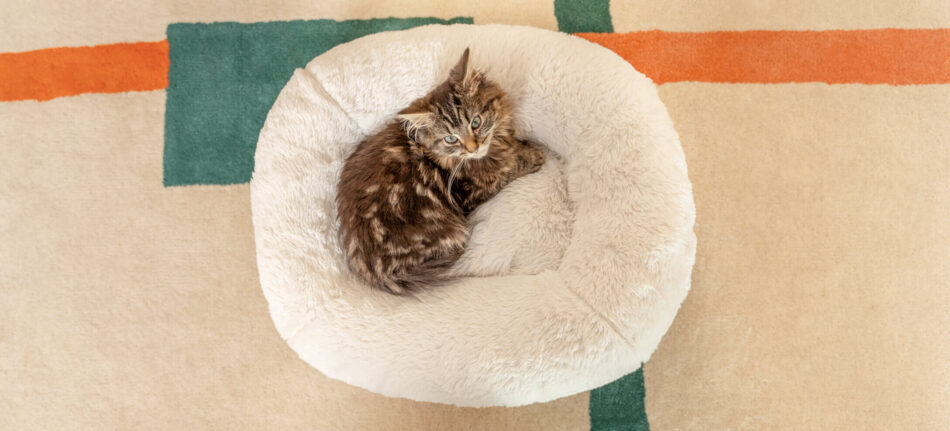
Why Do Cats Run Away from Humans?
Despite your best efforts cats may feel a bit neglected due to changes in your life such as a more demanding job, a new partner or a baby, which would naturally require more of your attention. You may have less time to devote to your kitty, which can make them look for attention elsewhere. A cat’s personality craves attention and play, and even though they may act like they don’t need their cat person, they really do.
Make sure that you dedicate some time to your cat, and why not provide them with a Freestyle outdoor cat tree setup which is an excellent source of entertainment and exercise, especially if you are perhaps a little busier than usual. Your cat will thank you!
Humans are Much Bigger and Can Seem Intimidating
Cat owners naturally adore their whiskered freinds and would do almost anything to protect them, however, it’s worth taking into account not all humans feel the same, with some even being afraid of cats. Many cat parents will be recognizable to their kitty babies, but they may feel a little intimidated by humans they have not come across before. Cats can certainly pick up on any negativity from humans that might not be so welcoming to a small four-legged furry friend.
You Might’ve Been too Rough with Them
Cats are not as tough as they might seem, and remember, they are only small creatures! Your strength could be overpowering to them and frighten them. So when you are playing with them, be careful that you’re not too rough! When there are small children around, it is important to keep an eye on how they behave around cats, especially if they don’t have any of their own. Children might not understand how to play and often tug at the tail, which certainly will not impress our furry feline.
How Can I Stop My Cat from Running Away from Me?
Take into account your current home life and any changes, whether there are other animals to contend with or new humans to get used to. Cat’s don’t like to feel second best, so there are feline aids that will make them feel extra special, like the Luxurious Maya Donut Cat Bed that will leave your kitty feeling like a king or queen. It is important to build a good relationship with your cat and understand their unique personality.
Build Trust
Whether you bring up your feline from a tiny kitten or take in a shy rescue cat, your relationship with them as the primary caregiver needs to be consistent. The trust between this small creature and their cat parent is fundamental to their happiness, and ultimately yours too!
Positive Reinforcement
Reward your kitty cat whenever required to do so, because knowing that they are loved will reinforce their desire to stay with you and not try to escape if the moment presents itself.
- Entertain your cat with fun and stimulating cat toys by exploring the fun side and predatory behaviors rather than trying to diminish it
- Provide more accessories to their customizable Freestyle cat climbing frame
- 2 legged human companions respond well to the occasional promise of chocolate or sweets and that includes cats! Reward them with some tasty cat treats
- Love, lots of love! Shower your cat in love, which will ultimately be the best reward ever!
Create a Safe Space
In a potentially unsettled environment, if you have moved house, welcomed a new member to the family or have suffered a loss within the family your cat will feel this unsettled feeling in the same way. Make sure you provide a safe and secluded space for your cat, like the Omlet Maya Indoor Cat House, which gives your pussycat a super snuggly cozy house away from any disturbances. Introducing your cat to a new house might take a little time, but we can help you get your cat used to a cat house and they will be purring away with happiness in no time.

Conclusion
It is very important to provide a safe home for your cats and gradually get them used to a new routine if anything changes at home. Cats love order and change can cause them to feel stressed, scared or even unwanted. When cats feel threatened, they usually respond in three ways to the object, individual or circumstance: fight, flee or freeze. Sadly, for us, cats running away from home is more common than we would like, and while the prodigal pussycat will often return when they please, it is important to be prepared for every possible situation. For peace of mind, ensuring that your cat is microchipped with up to date information is very important, and for the owners of indoor cats who don’t roam freely, give them the sense of the great outdoors and feed their curiosity with an outdoor catio, or a cat balcony enclosure.
This entry was posted in Cats
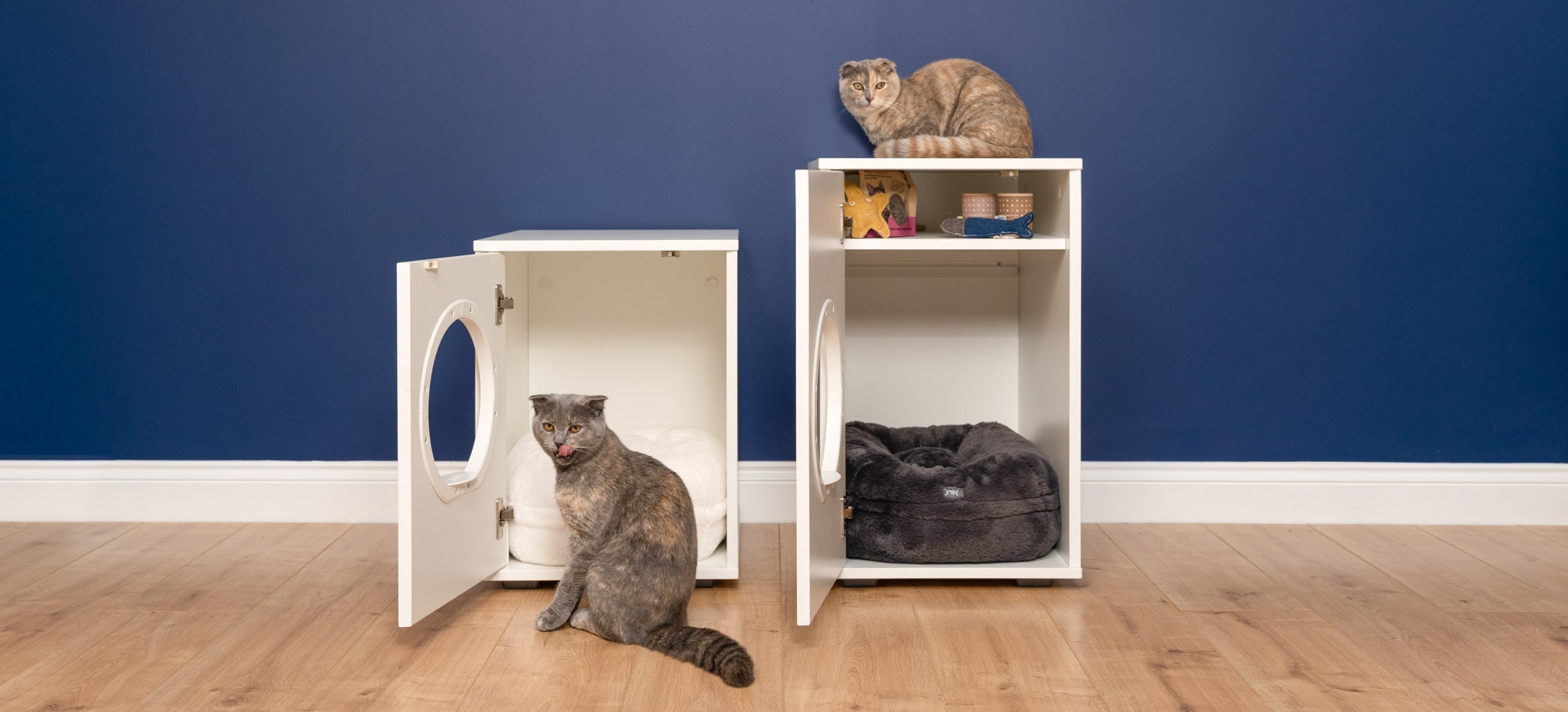 While cats can be great companions, most love having their alone time too. This is because cats are solitary predators, meaning that they hunt alone as opposed to in packs like our canine furry friends do. Cats will also establish their own territory via spraying, ‘claiming’ an environment as their own, which is somewhere they should be left undisturbed. This is why it’s a good idea to invest in a cat house – a safe and quiet space for your cat to relax in privacy, away from the chaos of the rest of the household! But how do you get a cat to use a cat house?
While cats can be great companions, most love having their alone time too. This is because cats are solitary predators, meaning that they hunt alone as opposed to in packs like our canine furry friends do. Cats will also establish their own territory via spraying, ‘claiming’ an environment as their own, which is somewhere they should be left undisturbed. This is why it’s a good idea to invest in a cat house – a safe and quiet space for your cat to relax in privacy, away from the chaos of the rest of the household! But how do you get a cat to use a cat house?
Firstly though, if you’re unfamiliar with what a cat house is exactly, they’re a shelter specifically designed for cats to be able to retreat to. Whilst some cat houses are designed to stay outside in the garden, should you have an outdoor cat, they’re not an alternative to your cat living inside of the family home. Think of it more like a home within a home for your pet.
A frequently asked question is whether cats actually like indoor cat houses. The answer to this is yes! If your cat has never used a cat house before, it could take them some time to get fully used to the idea, and they may not immediately take to their new cat house. However, rest assured, there are steps you can take to get your cat comfortable within their new shelter and once they’ve settled in, they’ll love getting cozy in their own little den!
How Will My Cat Benefit from a Cat House?
Indoor cat houses are beneficial to cats for a number of reasons, as we’ll find out. Furthermore, the Omlet Maya Indoor Cat House is great for humans too! The stylish and easy-to-clean design will fit into your home perfectly, doubling as a storage facility, making for an ideal solution all round.
Privacy
If you live in a fast-paced household, your cat might not always appreciate being the center of attention! A cat shelter will be beneficial to your cat in that it allows them to have privacy in their own shelter, moving them away from the hustle and bustle of the home.
Safety
Another benefit of a cat house is that they provide your pet with an enclosed environment, which gives them an element of safety. If you’re a cat owner, you may be familiar with cat hiding behavior, which cats do because a secure space can make them feel safe. It’s not usually anything to be concerned about, unless it becomes excessive, which could then be a sign of an underlying issue. If you notice your cat also avoiding eye contact, running away, or tucking their tail under them, they may be suffering with anxiety. In this circumstance, it’s always a wise idea to get advice from your vet, however, a cat house offers anxious cats their own hideaway within the family home, that will give them assurance that they have their own ‘safe zone’.
Comfort and Coziness
A cat house will also provide your cat with a comfortable, cozy, and warm space, which is especially important during the colder months. You can place your cat’s bed inside of their indoor cat house, so they can enjoy sleeping and relaxing in their snug shelter.
How do I Get My Cat to Use a Cat House?
Just as you’d make your bedroom your own with cozy furnishings and decorations, it’s important that you make your cat’s house into a home too! By creating an environment your cats love, it will make it a lot easier for them to get into the swing of getting into their cat house.
Treats
It’s important that your furry friend associates their house with being a positive environment. One way to do this is by using cat treats to lure them in. Simply place some of your cat’s favorite treats in and around their cat house and watch as they are unable to resist going in. This form of positive reinforcement will make for a much simpler transition. Once your kitty has realized that the shelter is somewhere they actually enjoy going to, you should no longer need treats to guide them in, and they should willingly walk in by themselves.
Catnip
Why not try some catnip? – a firm favorite amongst a lot of cats, due to effects of the chemical compound nepetalactone, found in the leaves of catnip. You can read more on why cats go crazy for catnip in this previous blog here. Unless your cat is unreactive to the substance, the scent can’t be missed by cats, so it’s a perfect method for trying to get them to enter their shelter. You can use catnip either in its natural form, dried or flaked, or in catnip treats. Just as you would with regular treats, simply sprinkle your catnip in and around their cat house to tempt them in.
Toys
If your pet is a fan of catnip, Omlet also provides a number of cat toys that contain the ingredient, which can be used to entice your cat into their house. this can be used to entice your cat into their house. If your cat isn’t too big on the stuff, don’t worry, as you can use any other type of cat toy that they really enjoy playing with. Initiating play with your cat and any of their favorite toys outside of their cat house, again will allow them to make positive associations with their house, teaching them that great things happen when they go near the shelter!
Chase toys are particularly good for this activity, as it will mean that your cat could end up chasing the toy directly into their house. Cats have a natural instinct to chase, meaning that many go wild for these types of toys.
Additionally, once your cat has settled into their house, it can also be used as storage for their toys!
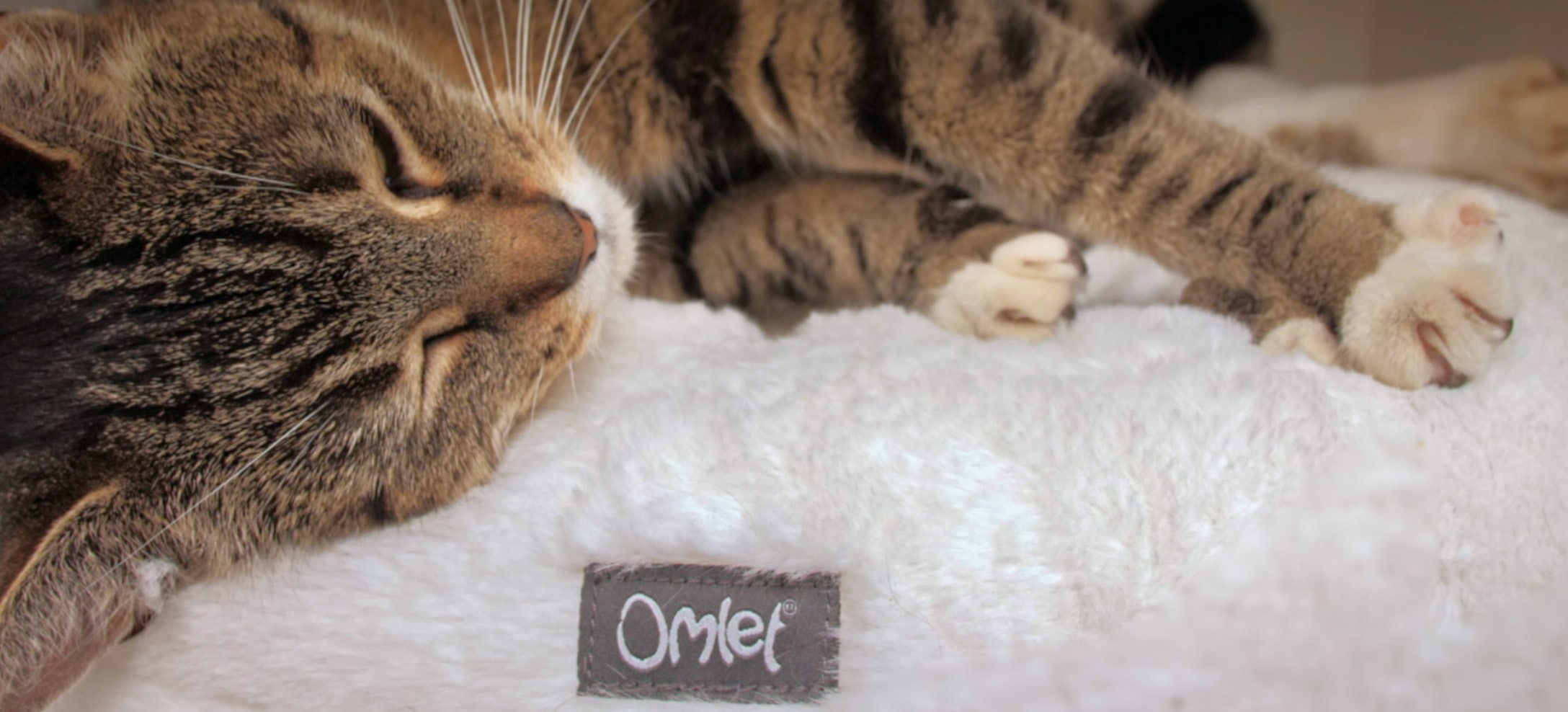
Comfy Bed
Placing a comfy bed on the floor of their house is one way to get your kitty to use their house. Since your cat could end up spending a lot of their time in their den, it’s only right that their bed provides them with an optimum level of comfort. The Maya Donut Cat Bed is a great option to go for, with a deep cushioning that will have your cats sinking into the bed of their dreams.
Warm Blankets
With winter round the corner, placing a blanket inside of your cat’s den will be warmly welcomed by your pet. You can also position a soft blanket on top of your cat’s bed inside of the shelter to give it more of a luxury feel and have them keep even more cozy. Just as a comfy bed can work to tempt your cat into using their house, a warm blanket will be equally irresistible.
Where Can You Put Your Cat House?
 There are a number of different areas in your home that may be appropriate to place your cat house. This depends on your living situation, and your cat’s preferences. Do they like to be involved with family time or would they prefer to have their shelter in their own quiet room? As we earlier mentioned though, if you have outdoor cats, it’s not recommended that you place your Maya Indoor Cat House outside, as it is designed for indoor use only.
There are a number of different areas in your home that may be appropriate to place your cat house. This depends on your living situation, and your cat’s preferences. Do they like to be involved with family time or would they prefer to have their shelter in their own quiet room? As we earlier mentioned though, if you have outdoor cats, it’s not recommended that you place your Maya Indoor Cat House outside, as it is designed for indoor use only.
When deciding which room to put your shelter in, you may also want to consider factors for yourself such as how easy it will be to clean and whether it will look right in your home.
In a Quiet Room
As mentioned, most cats prefer a quiet life. If this is applicable, then a quiet room would be the perfect location for your house! If you have a room in your home that is not frequently used by other members of the household and is also not close to anywhere in the home where you can hear a lot of noise from the outside e.g. traffic or noisy neighbors, then this could be the right solution for you and your cat.
The Kitchen
Maybe you have a cat who likes to be more involved with family time. If this is the case, the kitchen might be best suited to placing the indoor cat house in. Furthermore, if you keep your cat’s food and water bowls in this room, then it will mean they’ll have the convenience of this too!
The Living Room
Similarly, you can also place your indoor shelter inside of the family living room, if your cat doesn’t mind a bit more noise. With the Maya Indoor Cat House, the contemporary and stylish design means that the shelter can fit in perfectly with any existing furnishings, so you needn’t worry about it clashing with your home. Furthermore, if you have any concerns about keeping a house in your living room from a cleaning perspective, the Maya Indoor Cat House can easily be hoovered and wiped down after use.
The Bedroom (If You Don’t Want Them on Your Bed!)
To have your pet in the bedroom or to not have them in the bedroom? This is a common debate amongst many pet owners, but there’s not a one size fits all answer to this question. While some cat owners rule pets out of the bedroom completely, some will happily doze off with their cat at the end of the bed every night. If you’re not particularly keen about having a cat on the bed but do enjoy having their presence in your bedroom, then you can try placing the house in a corner of your room. This way, you’ll have the benefits of sharing a room with your cat but it will save you from having to clean up any cat hairs from the bed and you’ll both have your own personal space – a win-win situation!
An indoor cat house is a fantastic idea for both cats and humans, even if your cat does initially struggle with using it. What is important is to be patient and not to give up if one method of helping encourage them to use it doesn’t quite do the trick. Hopefully with a few of our tips your cat will love using their cat house soon enough!
This entry was posted in Cats
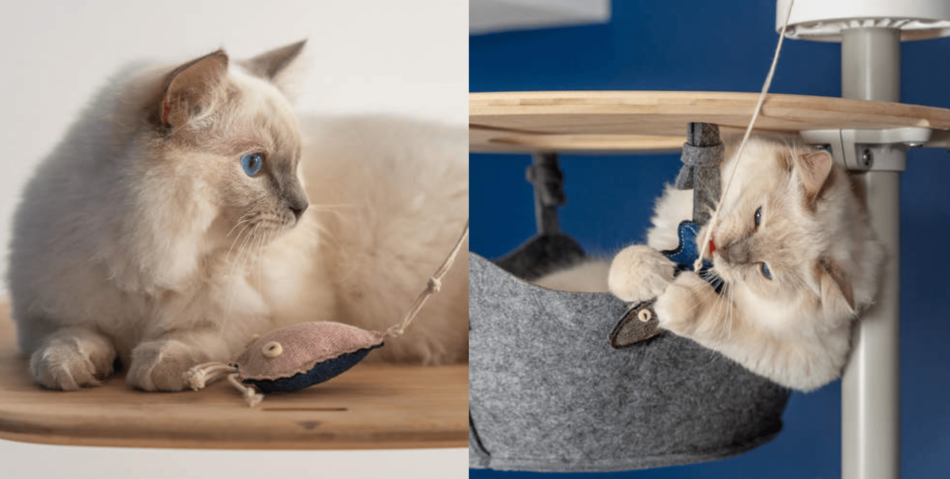
What Is Catnip?
Whether or not you’re familiar with cats, you’ll likely have heard of catnip. Renowned for sending cats “crazy”, catnip is actually a member of the mint family that also goes by the name of Nepeta cataria. The plant grows in Europe, Asia, Africa, and North America, containing nepetalactone, an oil, or chemical compound, found within the catnip’s leaves.
When cats sniff catnip, the nepetalactone enters their nasal tissue, sending signals to the brain. This stimulates sensory neurons, targeting receptors that usually result in behavioral changes. As your cat reacts to the herb, you may witness them shaking their head, licking, rubbing, leaping, or rolling around. Their behavior can also mimic a cat being in heat, even for male cats, with others displaying feelings of euphoria through being overly affectionate, relaxed, or playful.
How Can I Use Catnip?
Catnip is widely available in a number of forms. Although you can use the plant directly in its fresh, natural state, most commonly, catnip is found dried, or flaked. This can be used on anything including toys, bowls, or simply be scattered around your home. Alternatively, you can purchase catnip spray to spritz onto your cat’s favorite things. Catnip toys are also very popular, with the herb being used in a number of different types of toys including Omlet’s collection of ocean-themed Maya Cat Toys. However, don’t worry if your cat isn’t a fan of catnip, the toys are also available without.
Why Do Some Cats Not Like Catnip?
Seventy percent of cats will show some reaction to the plant, and whilst most go wild for the stuff, others simply aren’t interested or won’t respond to catnip. This isn’t anything to be concerned about and may be for two reasons. The first being that your feline friend lacks the gene that makes them responsive to catnip. The catnip response is hereditary, relating to the autosomal dominant gene which, interestingly, is not exclusive to domestic cats. Also found in big cats such as lions, fascinatingly, they too can be affected by catnip with effects lasting for up to an hour, compared to a reaction usually only lasting for up to fifteen minutes with our domestic cats!
Equally, your cat’s age may be another reason as to why they seemingly do not like or are not interested in catnip. Catnip is not harmful to kittens; however, researchers have found that kittens under eight weeks old show no reaction to catnip. Cats usually show signs of whether they’ll be a catnip lover or not by the time they reach around six months old.
Benefits of Catnip
Anxiety Reducing
As we earlier discovered, catnip can have a sedative effect on cats. Consequently, this can help with their stress levels and in turn, work as a natural form of anxiety relief.
Pain Relief
Research suggests that cats may actually benefit from catnip as pain relief. The plant has the potential to work as a short-term solution for cats with muscle pain or arthritis, similarly to how aspirin or paracetamol works for humans.
Encourages Play
With cats often becoming highly energetic after interacting with catnip, this encourages play and exercise, even more so with catnip toys that are bound to give your cat hours of enjoyment. If your cat is particularly playful, they’ll have great fun chasing around the Maya Cat Wand Toy with catnip, and the detachable wand makes it easier for you to raise the toy up high.
Can Help with Bath Time
If you’ve got a cat that doesn’t love bath time quite as much as they love catnip, then adding catnip to their bathwater might make things a lot easier for the both of you. Catnip can make a bath a lot more appealing for your pet, which you can do by adding up to a teaspoon of flakes to boiling water, allowing it to soak, and then putting it into the bath.
If you do decide to give your cat a taste of some catnip for the first time, you’ll want to initially start off with a small amount to gauge their reaction. Should your cat respond well, you can continue to incorporate it into their routine up to a few times a week. Fortunately, catnip is a completely safe product, and your cats will not be able to overdose from it. At worst, your cat may experience some digestive issues, however, most cats will let their owners know when they have had enough by refusing.
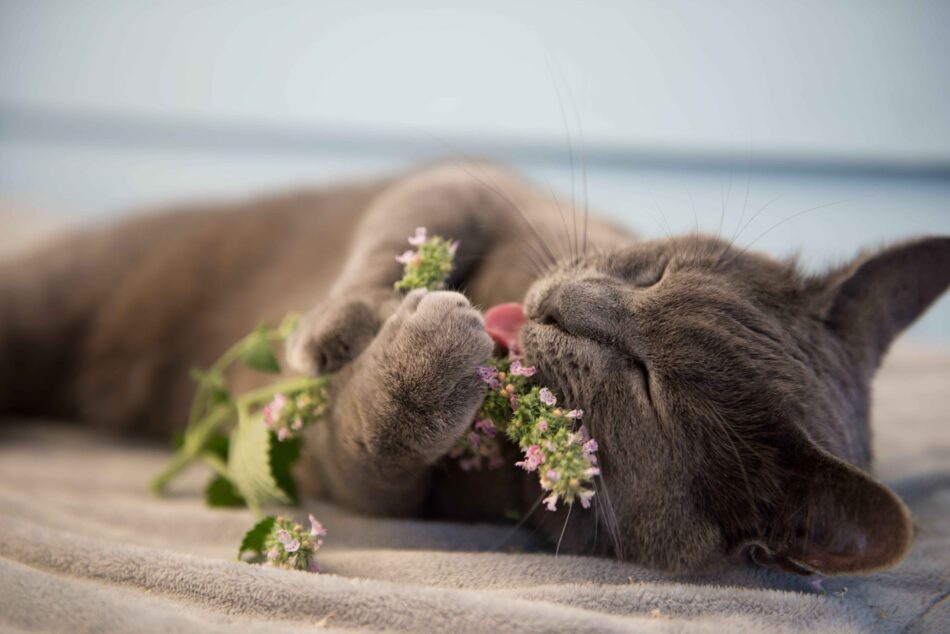
This entry was posted in Cats
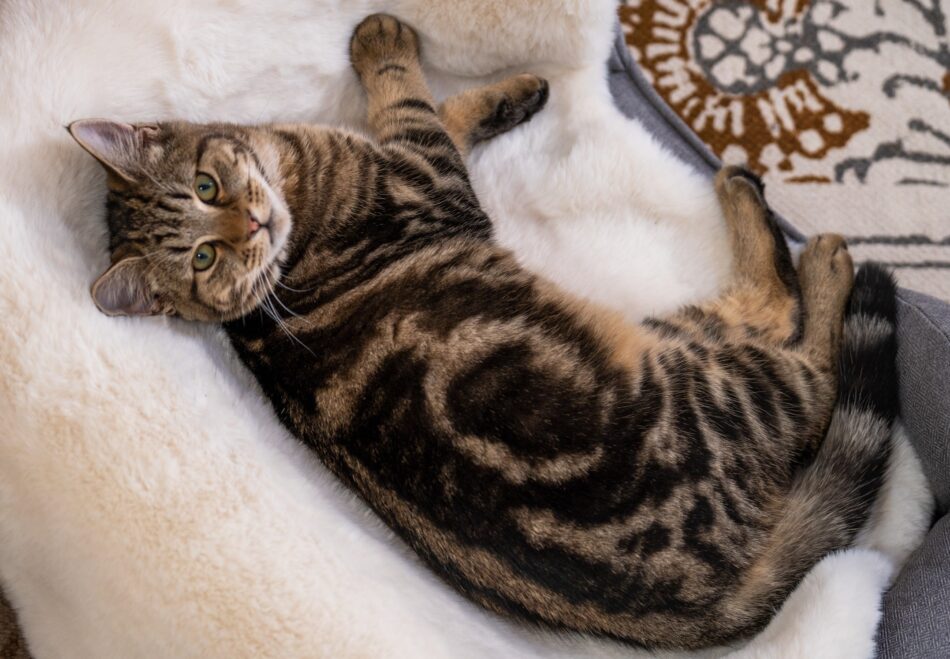
Let’s face it – all cats shed, and keeping your home free from loose fur and other messes isn’t always easy. But keeping on top of a fuss-free hygiene routine and having the right products for your purry pal will have your house clean in no time! Keep reading for feline-approved top tips.
Grooming goes a long way
Grooming does way more than just make your cat look great. It’s also important for getting rid of loose fur from their coats and your home. If you’ve got a bit of a fussy feline on your hands, try placing down cat grooming mats on the table and chair legs in your home. This way, kitty can avoid the brush but it still means getting a groom. These mats cling to the loose fur so that it doesn’t float through your home. Plus, you can easily pull hair out from the mats and clean it as necessary. Still in need of some cat fur-collecting techniques? Read our complete guide on removing pet hair from your home.
Say goodbye to litter box mess!
Another source of mess in our homes with cats is their litter box. Not only because of the odors and unsightly mess that comes with it, but cats will also carry out the litter on their paws, also known as ‘tracking’.
Thanks to Omlet, there is a solution to all of the above! The Maya Jump On Top Entry Cat Litter Box features an anti-tracking platform which, once they’ve done their 1s and 2s, cats will step out onto before jumping down from the box. The platform has tiny holes which allow the loose litter to fall through and back into the litter box as your cat jumps out! This significantly reduces the amount of litter they carry out with them, meaning you won’t step on tiny grains of litter.
If that wasn’t clever enough, the anti-tracking platform also has an active carbon filter. This effectively absorbs and controls bad odors before they emit from the litter box. Plus, the litter box has a wipe-clean, waterproof liner which makes it super easy to maintain a clean, odor free and hygienic environment all in a discreet, furniture-style box that will give kitty the privacy they desire.
Air-purifying, cat-friendly plants
Air-purifying plants in the home help to improve air quality and contribute to a fresher, hygienic feeling for everyone. There are lots of cat-friendly plants, such as the Boston Fern and Lavender, which will have your home smelling great! If your cat likes to play with plants, claw at the soil or chew on the leaves, you might want to consider smaller plants out of reach, or more robust plants.
Cat sheets need changing too
It’s much easier to maintain a fur-free, clean and hygienic home when living with a cat if their favorite sleep spots are easy to wash. That’s why we designed a cat bed with a removable, machine-washable cover…
The Maya Donut Cat Bed offers an easy clean solution! All you have to do is unzip the cover and pop it in the washing machine on a gentle cycle with a mild detergent. Leave to air dry and pop the cover back on – it’s super simple!
You can also raise the bed with stylish feet, which not only look great but also improve airflow beneath the bed to prevent a build-up of fur, dust and moisture and protect your carpet. The Maya Donut Cat Bed is a great hygiene solution, and is super cosy and soft for cats who desire the best!
Protect your furniture with easy-to-clean blankets
If your feline friend prefers to curl up on the sofa, you can encourage your cat to sleep in their own bed to protect your furniture from fur, dirt and sharp claws! But if you’re still working on convincing them, a dedicated cat blanket, or two, is a simple solution to creating a barrier between your nice clean sofa and your cat’s fur and mucky paws. The Luxury Faux Sheepskin Cat Blankets are super duper soft, and they’re available in three sizes! Your cat simply won’t be able to resist snuggling down on these dual-sided, quilted throws!
Have a pet-safe cleaning kit on hand
A strong vacuum cleaner is an obvious choice to keep pet fur at bay, but there are other essentials you should have in your pet-safe cleaning kit. Lint rollers are super handy for running over clothes, cushions and blankets to quickly lift any clumps of loose fur. Fabric freshener sprays are also a must for eliminating any bad odors which cling to curtains and sofas. A pet-safe carpet cleaner is bound to come in useful when you’re faced with muddy paw prints or other accidents!
Wipe clean feed bowls
Regularly cleaning your cat’s feed bowls is also an important step in reducing odors and maintaining hygiene in the home. Make sure they’re sturdy, can be wiped clean and in a quiet spot with little footfall. This way, your cat can have privacy while they eat, and the food smell won’t upset visitors or attract other pets and children! Putting the feed bowls on a wipe-clean mat will also protect your floor, especially carpets, from food mess or spilt water.
Keeping a clean cat home with Omlet
Keeping your home clean when you live with a cat doesn’t have to be a chore! Omlet has designed solutions to all of your cat’s needs, so take a look at our expertly designed Cat Beds, Cat Blankets, Cat Bowls and more to discover how Omlet can help you to keep your home clean, and your cat, happy!
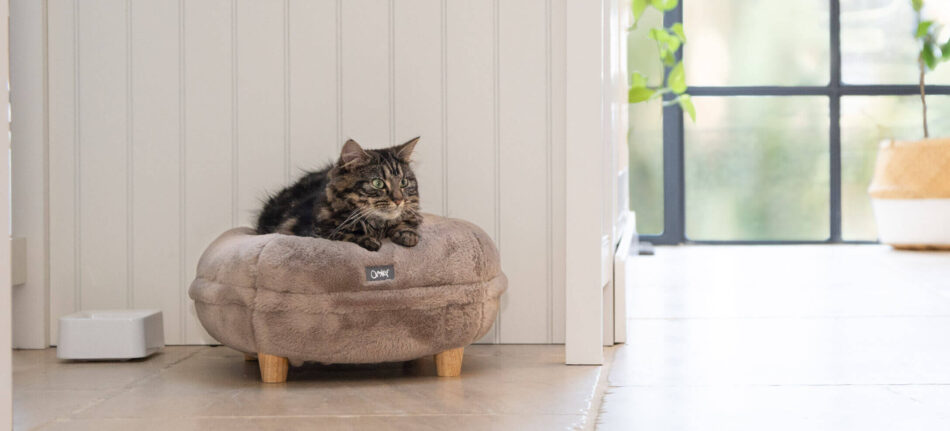
This entry was posted in Cats
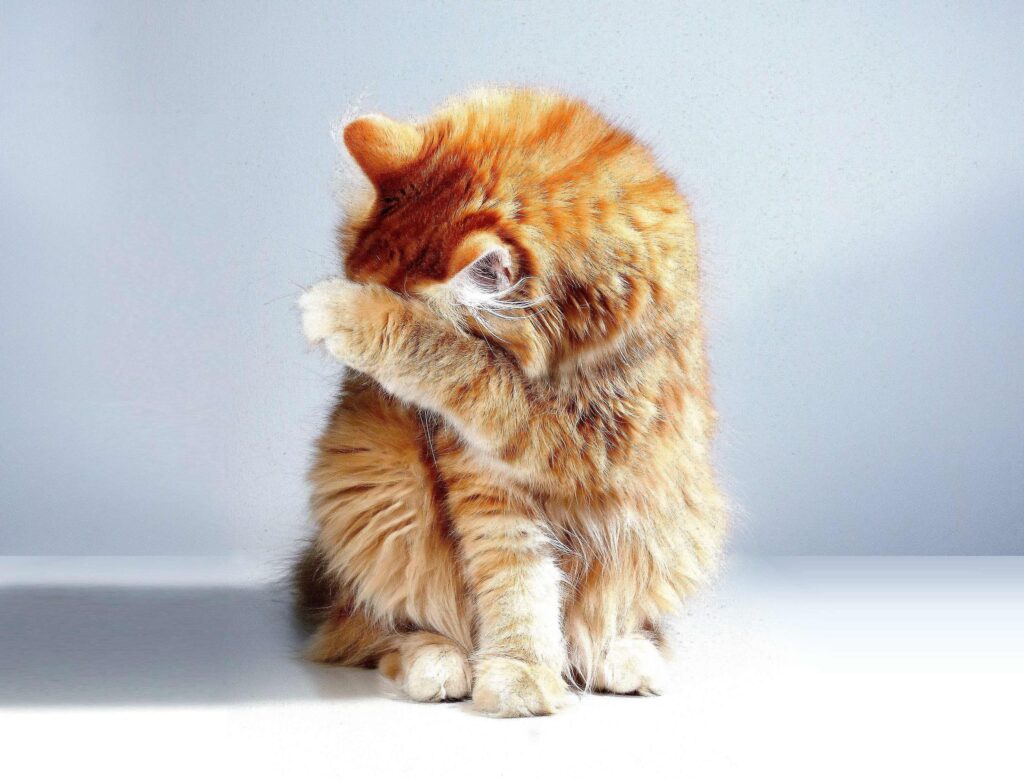
While some cats follow their owners to the bathroom and don’t understand the concept of privacy, many are still wary of who’s watching when they go to the bathroom themselves.
Some cats will do their business solely outside, others might do a bit of both, perhaps preferring a warmer toilet in the winter months. Many cat owners choose open litter trays, and don’t always have the option to have the tray hidden away.
But how do cats feel about doing their business?
Why do cats prefer to poop in private?
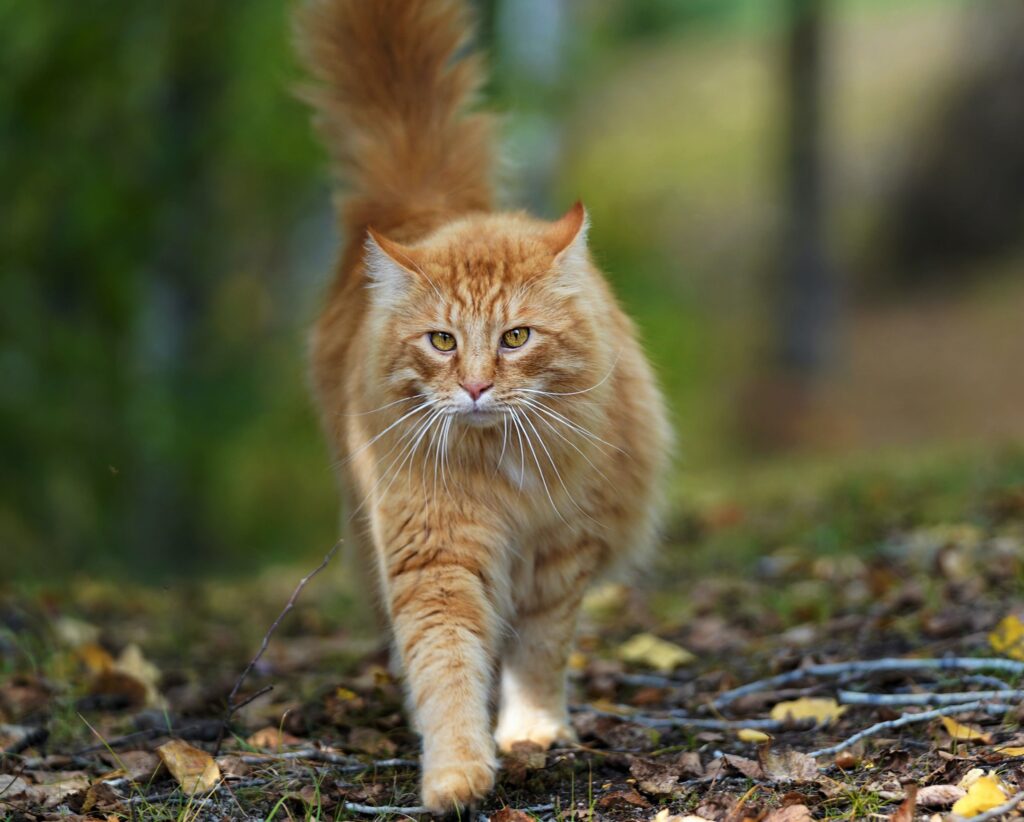
It’s easy to empathize with our feline friends’ desire for privacy when we remember the troubles their ancestors faced and the natural instincts that’re placed in our cat’s mind.
Cats have a deep-rooted urge to be alert at all times. Their desire to protect themselves and be wary of their surroundings extends to the toilet.
Using an uncovered litter box while other people are around can make a cat feel extremely vulnerable and exposed, this may especially be the case for anxious cats and rescues.
So, it of course makes sense that some cats may prefer to do their business in private, without disturbances, somewhere they can feel safe and comfortable to relieve themselves without the potential of being attacked!
What’s the best litter box for privacy?
Open litter trays give the most exposed and vulnerable bathroom experience for cats, and for you they offer the least in the way of odor and mess control. An enclosed litter box, such as the Maya Jump On Top Entry Litter Box, allows your cat to drop down into a dark and secluded litter box, giving them a feeling of peace and privacy to do their business.

The Maya Jump In Litter Box takes that privacy one step further with a high entry point where cats can jump in and step down into a completely covered litter box. In the Jump In, cats can feel completely at ease that no dogs, children or adults can watch or touch them while they’re using their toilet.
For you, the Maya Cat Litter Box also offers an effective odor control solution, reducing tracking mess around the home thanks to a grid platform which collects loose litter from your pets’ paws, and an easy wipe clean litter liner, with a cute underwater scene printed on the inside for your cats to enjoy.
The Jump In’s optional storage space is a great place to keep spare litter and poop bags, and the discreet pocket on the side of the litter liner holds a complimentary, fold-flat scoop, meaning everything you need for used litter removal is always on hand.
Best of all, this litter box fits in your home seamlessly, designed like a discreet cubicle, with no hint to what’s going on inside. This gives your cat that all important privacy and keeps all the mess which comes with loving a cat hidden out of sight from you and your guests.
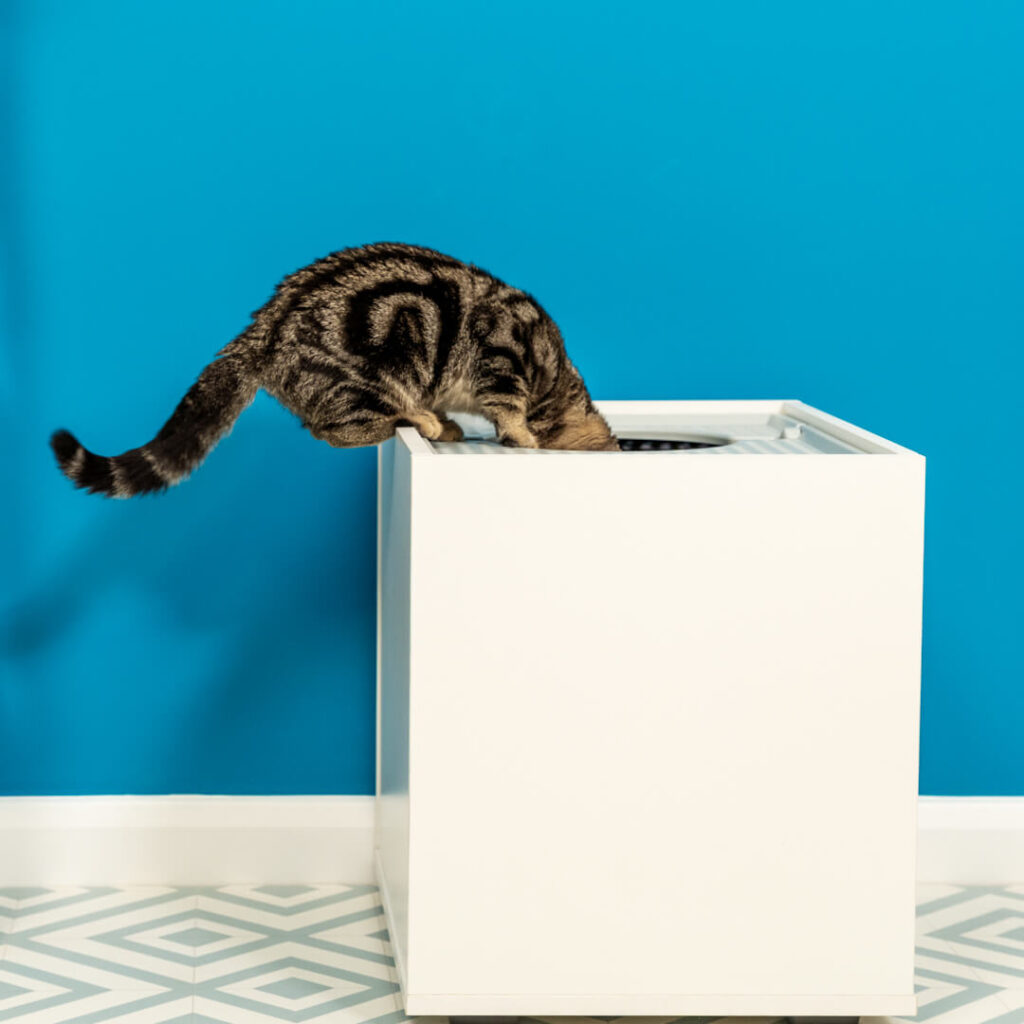 What else can I do to help my cat feel comfortable?
What else can I do to help my cat feel comfortable?
As well as an enclosed, private litter box, there are other things you can do to minimize any feelings of vulnerability your cat may have when they use the toilet.
If you notice your cat is visiting the litter box frequently but never leaving any mess behind, it might be a sign that they have been disturbed and not felt safe enough to do their business.
Leave the room for a while to give your cat the opportunity to use their litter box without noise and disturbances. If you have children or other pets in the house, encourage them out of the room with you so your cat has complete privacy.
If you can, place the litter box in a room which is not frequented often and rarely gets noisy, for example a bathroom or utility room.
Do cat’s dislike using dirty litter boxes?
Another reason for cats being reluctant to use their litter box or visiting without using it, could be that the litter tray has already been used and is dirty. Cats can be incredibly fussy about mess and filth in the litter box and may decline their used litter as to not dirty their paws!
Make sure you are regularly removing used litter from the litter box, and that you choose a litter with strong odor control qualities.
Use the fold-flat scoop in the Maya Cat Litter Box to remove the used clump of litter, and the loose, clean litter will fall back into the litter box through the fine holes in the scoop.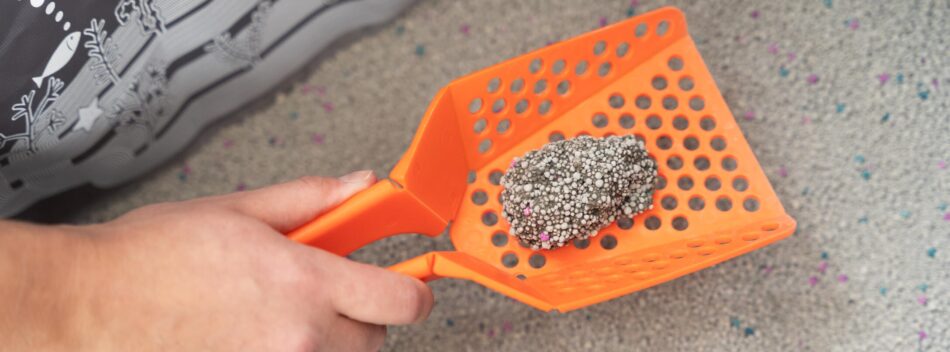
What are the best litter boxes for a multi cat household?
Covered litter boxes are also a wise choice for multi cat households where cats may prefer to do their business in secret from their house mates! Cleaning the litter box regularly is also key if the same box is used by multiple cats, and opting for fresh, hygienic type of litter such as provides longevity and ease of cleaning.
Some cats can also be fussy about sharing a cat litter box with a friend. While keeping it clean will help, the scent of another may put off your cat, and bringing a new cat into the home to share the litter box can make an existing cat feel especially annoyed. In this instance you may need to be prepared to get a separate litter box for different cats in the house.
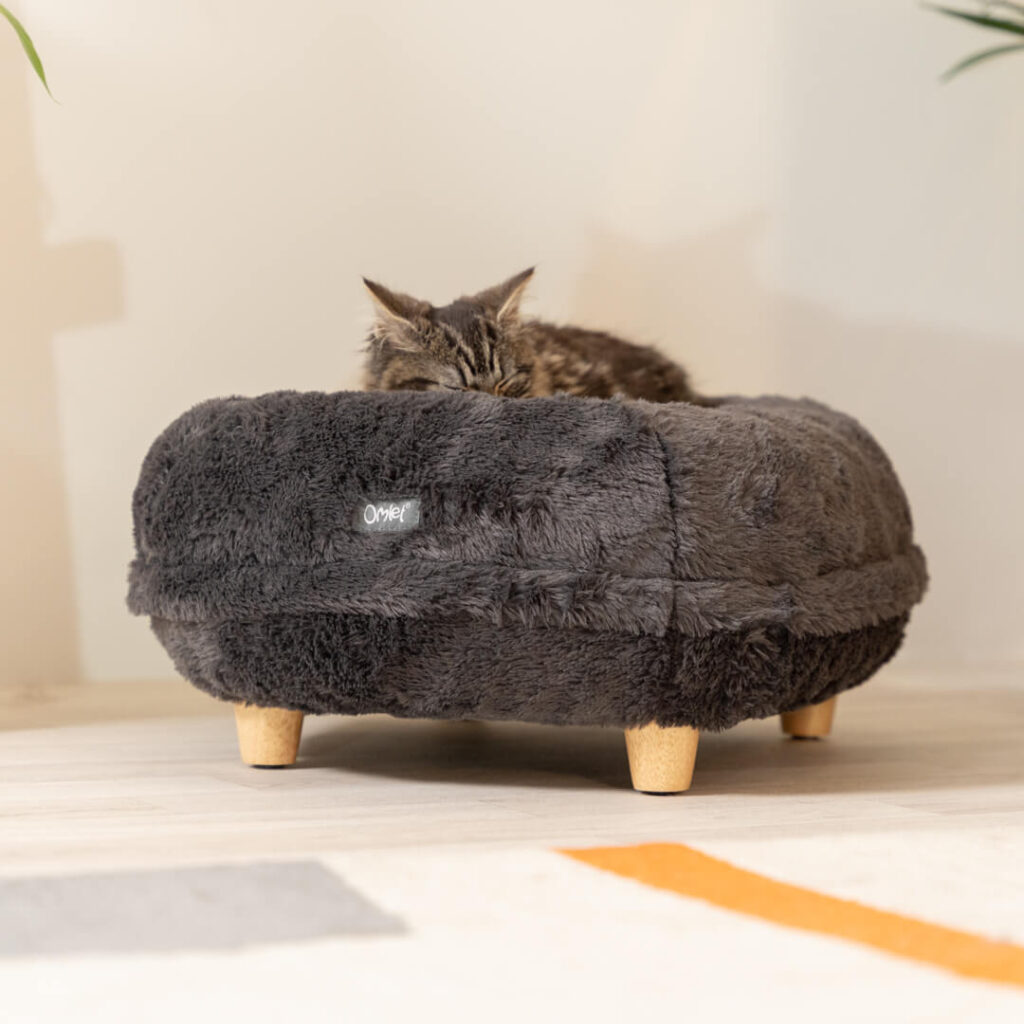 How and when to give your cat space
How and when to give your cat space
Giving your cat privacy extends beyond the litter box. Cats can also feel vulnerable and exposed when trying to sleep in a busy house and particularly anxious cats will search for a quieter spot in the home.
Consider where your cat chooses to rest during the day when the house is busy and make that space comfortable for them, for example, if your cat prefers to nap under a bed or chair, place a blanket or small bed, like a Donut Bed, beneath to make the spot cozy and warm.
If you have children and dogs in the home, it’s a good idea to keep them from your cat’s ‘safe space’ when your cat is resting or grooming.
Also consider where you have placed your cat’s food and water bowls. It may also be advisable to leave the room, or move them to somewhere quieter, where your cat can eat in peace without feeling threatened.
What’s the best litter box for a senior, disabled or pregnant cat?
While tall Jump In boxes will give cats peace and privacy, less agile cats will feel most comfortable with an easy access litter box that won’t cause them pain or discomfort. The Maya Walk In Litter Box offers just that, while still being a relatively covered and discreet litter box for cats who want to feel secluded and safe.
7 Reasons You and Your Cat Will Love the Maya Litter Boxes
1. Easy to clean cat litter box solutions, reducing smell and mess
2. A range of entry point options and litter box styles to suit all cats
3. Designed to fit seamlessly into your home like a piece of furniture
4. Enclosed litter box to give your cat the privacy they desire
5. Durable, reusable and long-lasting litter liners are easy to wipe clean
6. Includes a complimentary Omlet folding scoop in discrete pocket
7. Push-to-open door prevents accidental opening
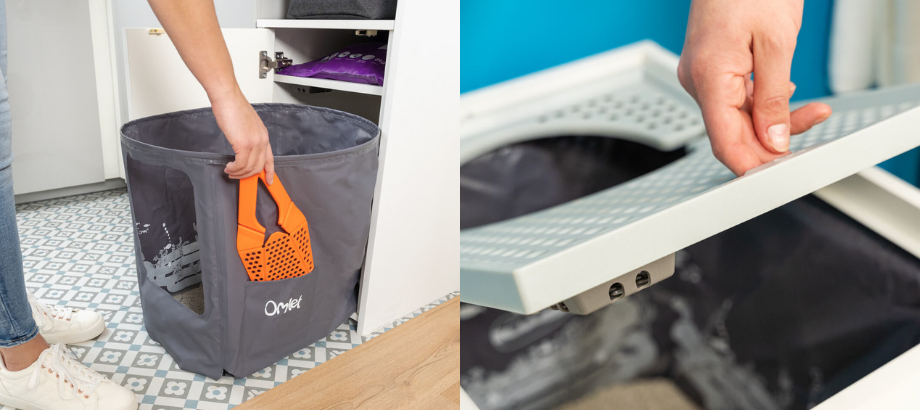
Which litter box should I choose for my cat?
All the Maya Cat Litter Boxes offer an easy clean solution and effective odor and mess control, in a discreet, seamless unit. Find the right box for you and your cat from the range of 5 entry points…
Jump On – Anti-Tracking & Low Mess
Walk In – Senior & Disabled Cat Friendly
Walk In + – Senior Cat Friendly with Storage
Jump In – Anti-Tracking & Discreet
Jump In + – Anti-Tracking with Storage
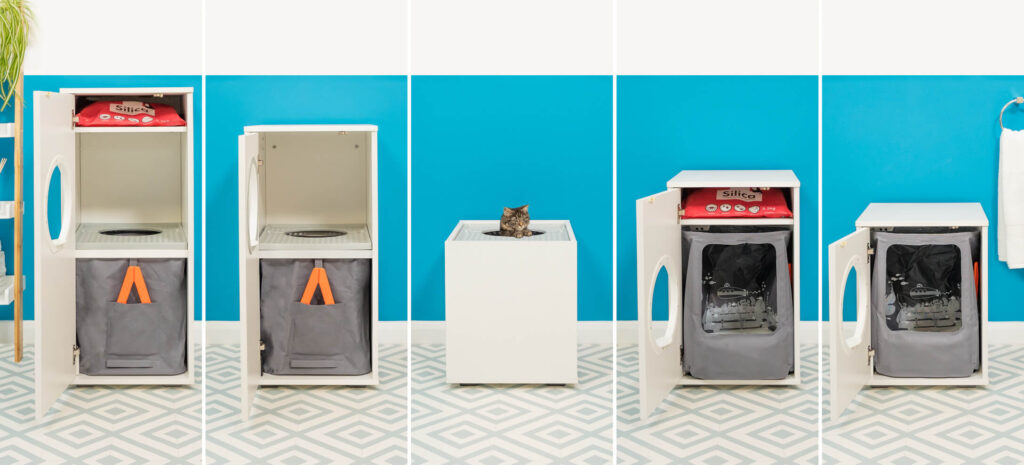
From left to right: Jump In with Storage, Jump In, Jump On, Walk In with Storage, Walk In
Discover Omlet Cat Litter
Our modern range of high-performance cat litter offers excellent odor control and highly absorbent particles to eliminate bad smells from your litter tray. With 5 different types of cat litter on an easy to compare page you’ll find the perfect litter for you and your cat.
Use our clever Cat Litter Selector to get an expert recommendation for your cat. We only sell direct, with competitive pricing and free delivery.

This entry was posted in Cats
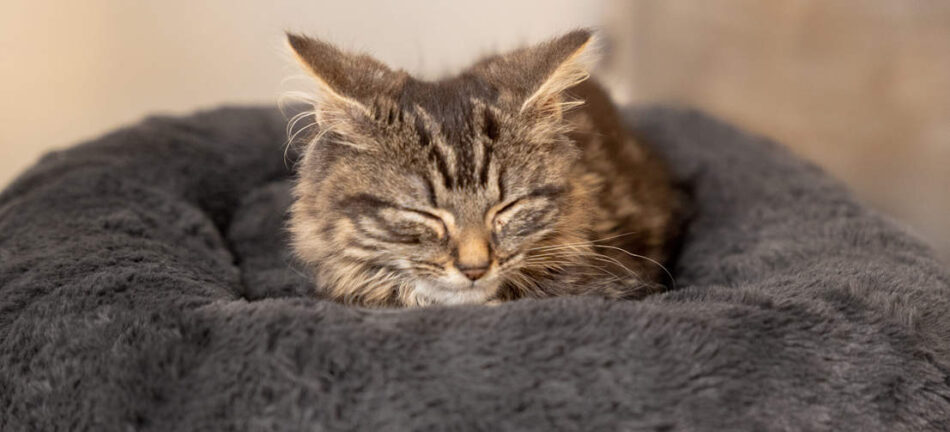
Have you ever taken a look at your cat’s whiskers and wondered why they’re there? Or why one cat’s whiskers are shorter than another’s? Read on to find out 10 things you might not know about cat whiskers.
1. Your cat’s whiskers can tell you how they’re feeling
Did you know that your cat’s whiskers can give you an insight into their emotions? A happy cat’s whiskers will be relaxed and slightly to the side, whereas a cat on high alert or hunting prey will have fanned out whiskers that are pulled forward. A fearful or shy cat, on the other hand, will try to make their face look smaller by pulling their whiskers back.
2. Cats are born with 24 whiskers
Cats are born with around a total of 24 mystacial whiskers – that’s 12 on each side of their face. This number will stay the same for the rest of a cat’s life!
3. Whiskers are connected to a cat’s nervous system
Whiskers are also called vibrissae, which means to vibrate. And because a cat’s whiskers are connected to their nervous and muscular system, this makes them highly sensitive. Therefore, when brushed against something, causing a vibration, whiskers will send signals to your cat’s brain to help them to navigate the world.
4. The world record for the longest cat whiskers is 7.5 inches!
In 2005, Missi the Maine Coon from Finland achieved the world record for the longest cat whiskers at 7.5 inches long! To put this into context, the average cat whisker only measures at around 3 inches. However, generally speaking, longer haired cat breeds do tend to have longer whiskers.
5. Whiskers can make cats better hunters
Whiskers can help a cat when it comes to hunting their prey. Initially, a cat’s whiskers will determine whether they will be able to squeeze into an enclosed space to make their catch. Their whiskers will then help them to identify the shape of their prey, allowing them to bite in the perfect spot.
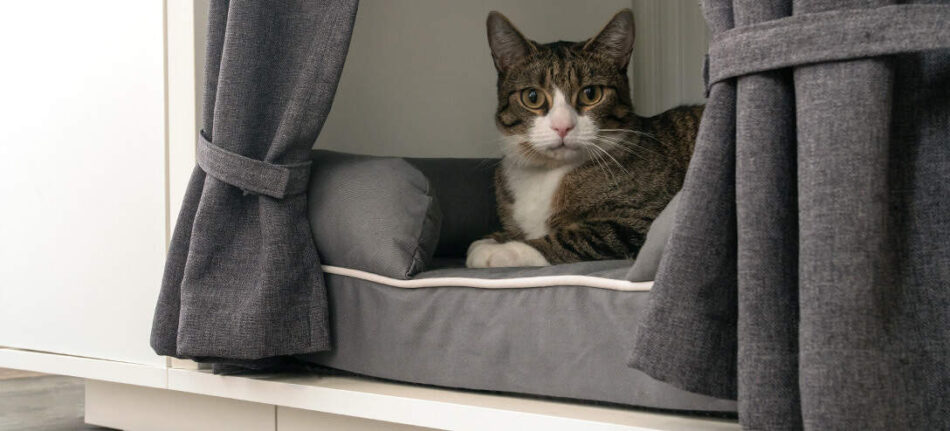
6. Whiskers help protect cats’ eyes
Just like our eyelashes, a cat’s whiskers also have the purpose of helping protect their eyes from dust and debris.
7. Cats have whiskers on the back of their legs
Whiskers aren’t just found on a cat’s face! Cats also have whiskers on the back of their front legs. These are known as carpal whiskers. Although they may appear to look like fur, carpal whiskers help with spatial awareness and hunting.
8. Sometimes mother cats chew off their kitten’s whiskers
If you’ve ever had kittens, you might have noticed a kitten’s whiskers being chewed off by their mother or even their littermates. Most commonly, cats do this either out of habit, as a sign of stress, boredom, or excessive grooming. To prevent unwanted behaviors, cats should be provided with a range of boredom busting cat toys to keep them both mentally and physically stimulated.
9. Cats shed their whiskers
You’ll no doubt have found your cat’s fur lying around the home, but what about their whiskers? Cats usually shed between 1 and 3 whiskers a year, which is nothing to be concerned about. However, if you notice excessive whisker shedding, this could indicate what’s likely a skin or stress issue, so should be looked at by your vet.
10. Your cat’s whiskers can change color!
As your kitty ages, you’ll probably notice their whiskers changing, or losing, color along with the rest of their coat. Depending on their breed, their whiskers will usually turn grey or black.
If you enjoyed finding out 10 things you might not know about cat whiskers, find out some more fascinating facts on cat’s whiskers and their senses in our previous blog The Seven Fascinating Senses of Cats.
This entry was posted in Cats
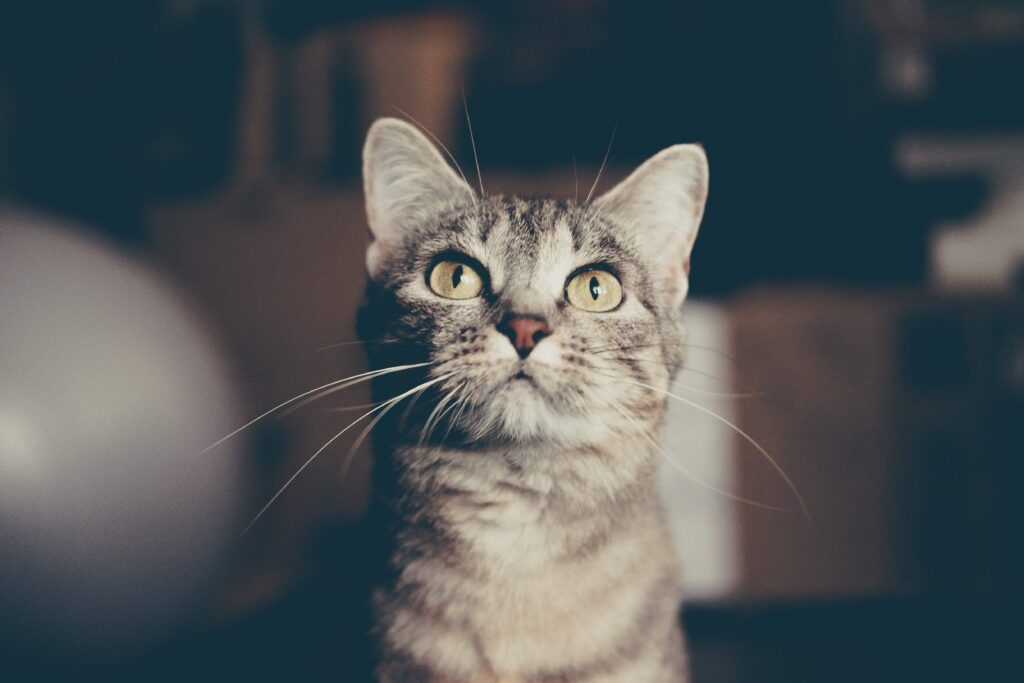
Photo by Erica Leong on Unsplash
As indoor cats frequently use their litter boxes, it is important for cat owners to take the right measures to keep litter box odors under control. Stinky cat litters, however, can be more than just an unpleasant aroma in the air around our homes. More worryingly, the smells coming from your cat’s litter box can actually be having an impact on yours and your cat’s health. However, with a few helpful tips on good litter box hygiene, you can be on your way to keeping pungent cat litter smells at bay, all while creating a healthier environment for both you and your cats.
What Causes a Stinky Litter Box?
A rancid smell from a litter box can often derive from a lack of, or poor, cleaning. Although you may be cleaning your cat litter box, if not done effectively, you may simply be masking the smell, as opposed to eliminating it.
Before anything else though, make sure that your cat is not spraying outside of their litter box, which can be one reason as to why there is an odor circulating your home. Your cat spraying outside of the litter box can be happening for a number of reasons such as boredom, territorial marking, and sickness. If you do, however, notice that your cat is simply refusing to use their litter box, the chances are, this is due to an issue surrounding the litter box itself. Some suggestions include
the litter box being dirty, (we wouldn’t like to use a dirty bathroom so why would our cats?); your cat disliking the litter you are using, based on either smell or texture (remember, cats have preferences too!); or the location of the litter box not being well suited to your cat/s.
A litter box should be placed in a quiet environment, away from the heart of the home or any outside traffic, to ensure peace and quiet. The litter box should also be separate from where your cat eats, have sufficient lighting, and within a room your cat likes or is comfortable in. The Maya Cat Litter Boxes are a great solution for cats who need complete privacy and comfort. With five different styles and entry points, your furry friend is bound to find a way to suit them.
However, if you do decide that it would benefit your cat to move their litter box to a more suitable location, which will in turn hopefully
help with the odor of the house, be mindful that cats are creatures of habit, so disturbing their space must be done with caution. Take it step by step with the litter box transition by purchasing a second box to place in the new location, while keeping the old box in its remaining place. After around a week, if your cat is using their second litter box, then feel free to remove the original, as this is a sure sign, they have comfortably made the transition. Another pro tip is to continue to use the same litter as you had before, which will make sure you’re not putting your cat under any more additional stress than need be when you replace their litter box.
Once you have ruled out that the smell is not from your cat spraying outside of their box, but in fact the odor is coming from what is going on inside of the litter box, you can begin to follow the appropriate steps to eliminate the stench and have your house smelling fresh again.
How to Control the Odor
 Regularly Wash the Box
Regularly Wash the Box
Although it may sound obvious, regularly cleaning the litter box is the starting point to waving goodbye to nasty odors. How often you give your litter box a deep clean really does depend on how often your cat is using the litter box along with other lifestyle factors such as age, diet and exercise coming into play. If you are starting to notice litter box odors becoming stronger with your current cleaning regime, up the frequency of cleaning and start giving the litter box a good scrub once a week. To wash your cat’s litter box, first remove and dispose of any litter, before beginning to scrub the box using warm water mixed with a mild dish detergent. Once cleaned, thoroughly pat dry with a towel. If you’re after an even easier cleaning solution for your litter box, have a look at litter liners, which prevent dirt from sticking to your box. The Maya Litter Box comes with a waterproof and long-lasting liner, making it simple for you to effortlessly wipe your box clean.
Keep On Top of Scooping Out the Litter Box
Scoop out your cat’s litter at least twice a day. It may initially seem a bit of an ordeal, but your cat really does prefer plenty of clean and dry space in their litter box to continue using it comfortably. Furthermore, frequently scooping the litter box means a lot less time for litter box smells to accumulate. It’s also important to replace the scoop itself, along with the litter box annually. This is because over time, the plastic scoop reacts with the acid in your cat’s urine, eventually causing the plastic to degrade and then smell.
Use a Clumping Litter
Clumping litter works by forming clumps when the litter gets wet, or your cat’s urine is detected. A great thing about this type of litter is that it makes it easier to scoop out all of your cat’s waste, before it has time to build up and cause an odor. If you’re on the search for a good clumping litter, clay clumping litter is a popular option, due to its absorbent properties. As clumping litter dries out cat feces, its absorbability makes it fantastic for preventing your cat’s waste from reaching the bottom of the litter box, which makes things a lot more difficult when it comes to cleaning.
Add Another Litter Box
If you’re lucky enough to have more than just the one cat, we’re sure you’re more than aware of how bad litter box odors can get! We all know how bad the smell can become from one cat’s waste, let another one, two, or three…! Purchasing another litter box, however, will definitely help you to fight nasty odors. Adding another litter box will help to control the litter box smell, as the rate at which cat waste piles up will significantly reduce. The general rule of thumb is to use one litter box per cat in the household.
Try a Cat Litter Deodorizer
A cat litter deodorizer should not be used to replace correct hygiene, however they’re a fantastic way to get your cat litter smelling wonderfully clean and fresh, once all other cleaning is complete. Deodorizers can come either as granules, beads, sprays, or in powder form, with a range of different scents on the market. Alternatively, you can use a scented litter, which also comes in a number of fragrances. However, just be mindful that some cats are more sensitive to new smells than others so may not take to scented deodorizers or litters. As another option, you can go for an unscented deodorizer, which works by neutralizing odors. These will be best for cats that are more prone to irritation from strong scents.
Charcoal Cat Litter
Just like clay, charcoal, or activated carbon, is highly absorbent, making it perfect for getting rid of nasty odors. To incorporate charcoal/carbon into your routine, you can either opt for a bag of cat litter with activated charcoal or carbon or purchase a cat litter deodorizer that contains it. The Maya Cat Litter Box comes ready with an activated carbon filter, that will prevent odors from escaping the box.
Use Baking Soda
If you decide that a cat litter deodorizer isn’t right for either you or your cats, using a little baking soda is another sure way to help with the odors coming from your cat litter box, although it may sound like an unlikely fix. Not only is baking soda a completely natural, safe, and pet friendly option for your cats, but it can also be used on any type of cat litter, working by absorbing your cat’s urine. A little baking soda goes a long way, so you will only need a couple of teaspoons, even for a large cat’s litter.
Dangers of a Dirty Litter Box
Dangers of a Smelly Litter Box to Humans
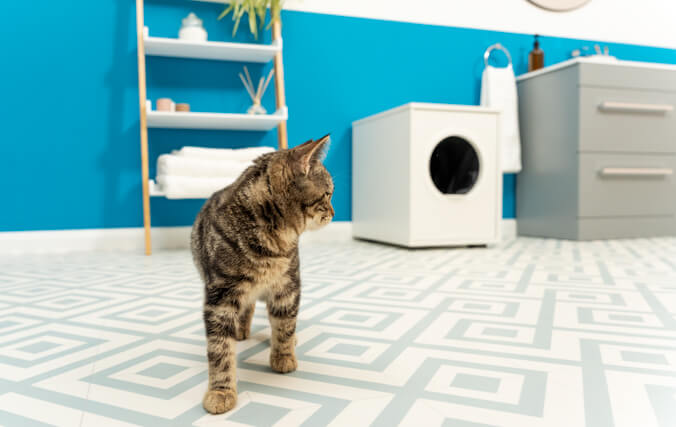 Ammonia is the most likely culprit for litter box odors, found in approximately 0.5 percent of your cat’s urine. As the litter box continues to accumulate waste within a room in your house that may not necessarily be well ventilated, the harmful gas of ammonia is formed. Overexposure to ammonia can result in queasiness and headaches, but should it become more serious, it can further lead to pneumonia. For those with a compromised immune system or are pregnant, overexposure to ammonia can be the onset of toxoplasmosis, an infection by the parasite toxoplasma gondii, which can become life threatening.
Ammonia is the most likely culprit for litter box odors, found in approximately 0.5 percent of your cat’s urine. As the litter box continues to accumulate waste within a room in your house that may not necessarily be well ventilated, the harmful gas of ammonia is formed. Overexposure to ammonia can result in queasiness and headaches, but should it become more serious, it can further lead to pneumonia. For those with a compromised immune system or are pregnant, overexposure to ammonia can be the onset of toxoplasmosis, an infection by the parasite toxoplasma gondii, which can become life threatening.
Cat scratch fever, or cat scratch disease, is a bacterial infection from Bartonella henselae bacteria, associated with cat feces. Although very rare, the disease can again cause dangerous symptoms such as fatigue, swollen glands and fever.
Dangers of a Smelly Litter Box to Cats
Cats really are clean animals, which means that many will only use a clean litter box, often resulting in cats doing all they can to avoid using a dirty one, even if it means uncomfortably holding in their urine. However, delaying using the bathroom is not a great idea for cats as it can cause urinary tract diseases such as bladder inflammation and kidney blockage, or failure. Although all of which can be treated by your vet, prevention is always better than the cure.
Cats can also unfortunately fall victim to cat scratch fever. Their symptoms are similar to those that we can suffer, with swollen glands, fatigue, and a lack of appetite being the most common.
Having a cat should not mean having to compromise on the smell of your home. Although the unpleasant odor from a litter box can be overwhelming at times, it doesn’t have to remain that way. Hopefully with a bit of advice, you can now be one step closer to saying goodbye to cat litter odors for good.
This entry was posted in Cats

When it comes to wildlife in the backyard, is your cat as ruthless as a raging lion or timid as a mouse? We might want to believe that our feline friend wouldn’t hurt a fly, but as descendants of their larger feline members of the family, cats are natural predators, whether we like it or not. But do all cats need or want to kill, and can you stop them from hunting? Sadly, the answer is no, despite spoiling them rotten or pampering their every need. Given the opportunity to go out and hunt, most cats will take it, purely because they have the animalistic instinct. So how can you make your cat’s interaction with wildlife in the backyard safer?
Hunter or hunted?
Even the most cuddly and affectionate cats can resort to their hunting instincts, but they’re not always the predator…
Allowing your cat to roam freely in the great outdoors isn’t always the safest and because they’re solitary creatures, they will hunt alone. This makes them more vulnerable to attacks from larger predators such as dogs, foxes, mink, and raccoons, as well as getting into fights with other cats and more human threats like cars, poisoning or thieves.
As a predator, our cats can impose a huge threat to our wildlife and nature’s neighbors. Your kitty is capable of killing wild animals such as birds, reptiles, and small mammals and while they don’t always bring the kill home, there is every chance they’ve already been consumed.
Hunting and hunger
Hunting is not solely motivated by hunger but the way you feed your cat will certainly make a difference to how they hunt. Cats are opportunistic hunters and know that if they were to hunt only when hungry, they could risk starvation, purely because capturing prey isn’t always successful and isn’t always available. Today, cats have evolved to change their daily patterns depending on the food that is available to them.
Ultimately, whether they’re hungry or not, hunting is an instinctual behavior. The average well-fed pet cat partakes in approximately 3 hours of hunting each day, whereas a cat that is fed less will hunt more, so it’s important to feed your cat at regular intervals throughout the day to mimic their natural feeding patterns. They’ll also benefit from a meal rich in meat content.
Cat safety
To avoid the hunting impact that your cat has on the local wildlife and protect them from predators and human dangers, we designed the Omlet Catio. Finally, cats can play safely in the fresh air! The Omlet Catio can be extended and adapted at any time to suit your cat and space and if you don’t have a large backyard, no problem. Introducing the Catio Balcony Enclosure – perfect for apartment balconies. Now, cats get all the stimulation they need while both they and the wildlife in your backyard stay safe.
If your cat does spend a lot of time outdoors and you’re concerned about wildlife and your cat’s hunting habits, there are a few things that can help.
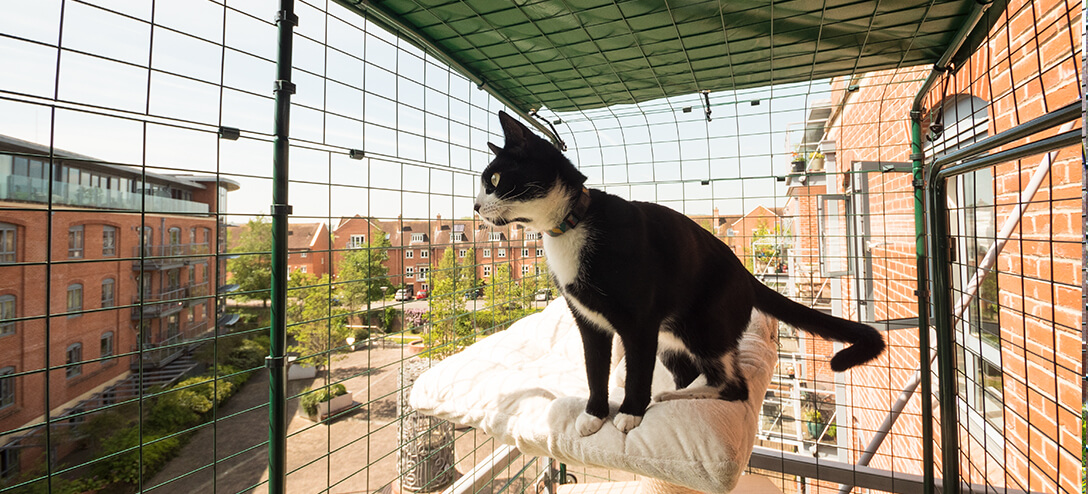
More time to play
Similar to their food patterns, the way cats play can affect how they behave in the wild. Regularly play with your cat and offer them cat toys that resemble prey. We’ve all seen the way cats crouch down ready to pounce on a scrunched-up ball of newspaper. If your cat doesn’t go out and is purely an indoor cat, don’t worry, you are not depriving them of their ancestral hunting heritage. Hunting doesn’t necessarily mean killing prey, which is why it can be adapted to play.
You can also introduce a cat scratching post for some extra brain stimulation. The Omlet Stak cat scratching post is perfect for cats plus the environment, made with durable cardboard that can withstand endless scratching sessions. Entertain your cat’s curious mind and hunter instinct rather than try and diminish it.
When not to hunt
Try to avoid dawn and dusk, prime hunting times. However, remember that changing a cat’s routine needs to be done slowly to ensure it’s not having a negative impact on the cat.
Cats need variety
Cats are neophiliac, which means they absolutely love variety – especially when it comes to food. Regularly providing different foods may curb their hunting behavior as they don’t need to look elsewhere for new tasty treats.
Sound the alarm
Adding a bell to the collar is certainly one way to alert prey that danger is coming, however, cats are incredibly intelligent. Just be mindful that while this may seem to work to start with, your cat might find a way to master this new skill of getting close without making a noise.
Omlet and your cat’s hunting
Omlet can’t stop your cat’s hunting but with products like the super secure Catio and Stak cat scratcher to keep them entertained for hours, your feline friend’s habit can be much safer for both them and wildlife.
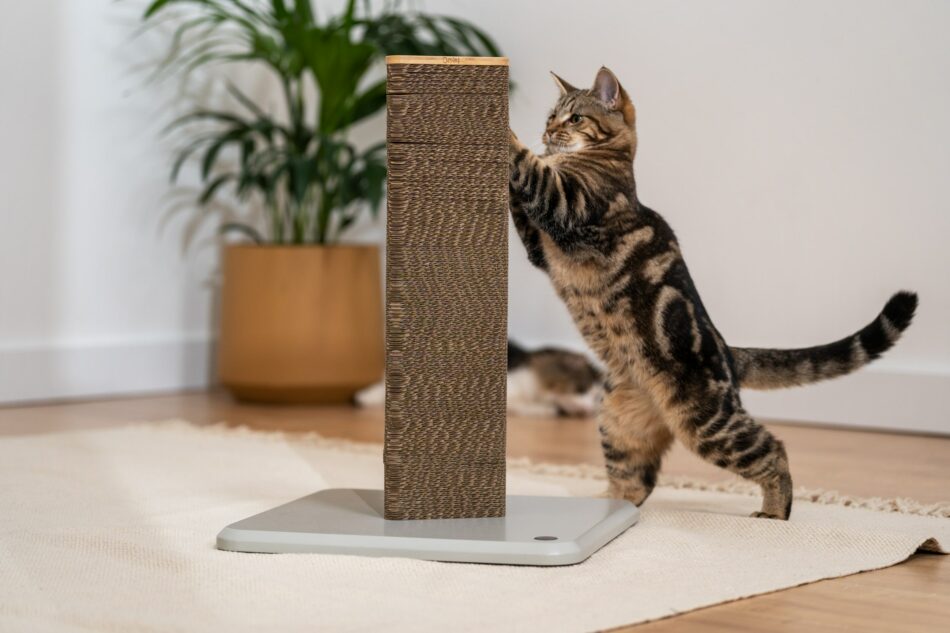

This entry was posted in Cats

Spring is the ideal time for a fresh start! Whether that means having one big clear out, starting a new project, or getting organized, it presents the perfect opportunity to have a bit of a change! So why not get your cat or dog involved with your spring overhaul so that they can start the new season in tip-top condition! So, how do you begin a spring clean of your cat or dog’s life?
Remove Pet Hair from Around the Home
Before making a start to your cat or dog’s own spring clean, grab the supplies and get to work on removing any pet hair or dirt from around the home. Many pet parents will agree that getting rid of animal hair from around the house seems to be an impossible task, especially if you’ve got a cat or dog that sheds a lot.
However, there’s no need for harsh chemicals when cleaning the house with pets. For your carpets, a top tip is to sprinkle down some baking soda before vacuuming. Not only will this help to remove hair, but the baking soda will minimize odors. Just be sure to use a vacuum that has been specifically designed for dog and cat hair to make things a bit easier!
When it comes to cleaning fabric sofas, you can simply use a dry sponge, and this will pick up any cat or dog hair lying around. For more household cleaning tips with pets, you can read our previous blog Cleaning Tips For Dogs Who Love Mud!
Using a pet blanket on top of beds and sofas, however, is the best way to keep your furniture protected in the first place, as well as providing your pet with a cozy spot to relax.
Clean Your Pets’ Beds
Now that the household spring clean is complete, it’s time to focus on your pet, and a great place to begin is by cleaning their bed. We wouldn’t like to sleep on a dirty mattress, so neither would our pets. And with dogs sleeping between 13 and 14 hours a day, and cats between 12 and 16, it’s fundamental to provide them with a clean, secure, and safe place to rest. Fortunately, all Omlet beds are conveniently easy to clean, with removable covers and toppers that are machine washable.
Alternatively, treat your cat or dog to a new bed this spring. For cats, the Maya Donut Bed comes in a wide range of colors that can add a touch of spring freshness to your home for the season. The Topology bed is perfect for dogs, with the option of raised feet, which improve home hygiene and airflow.
Give Your Cat or Dog a Groom
Spring cleaning wouldn’t be complete without a bit of a pet makeover! Well, not necessarily a full head to paw transformation, but a good bath and brush go a long way! Depending on the breed of your dog or cat, they might need to make a visit to the groomers, but it’s a good idea to keep on top of a basic regime at home. Furthermore, grooming is not only for your dog or cat’s appearance but is also important for your pet’s health by aiding with keeping their skin healthy and preventing fleas or ticks for example.
Treat Your Pet to Some New Toys and Outdoor Entertainment
Spring means some warmer weather is on the way, so both pet owners and our furry friends will be spending much more time outside. A few new toys will be greatly appreciated by your cat or dog, as they adjust to the new season after spending a lot of winter cozied up indoors. Or how about treating your cat to their very own outdoor cat run, which is perfect for indoor and outdoor cats alike, who love adventuring but need to remain safe in the garden.
Prepare for the Heat
Before we know it, summer will be here, so why not get prepared as early as possible by giving your pets the best chance of staying protected from the heat. Something to invest in during spring is a cooling mat for your dog. The Omlet Memory Foam Cooling Mat has a non-toxic self-cooling gel inside, meaning that the mat doesn’t require any refrigerating. You can place your pup’s mat either on a flat surface or on their bed and they’ll stay nice and cool for up to three hours – the perfect summer accessory!

The Omlet Cooling Mat is super easy to clean, with a quick wipe down!
Spring is just around the corner, so there’s nothing stopping you from beginning your tidy up from today! Before you start cleaning your home, however, it goes without saying that any cleaning products you use in your house should be pet-safe, so always make sure to check the labels. How will you be spring cleaning your cat or dog’s life?
This entry was posted in Cats


































 There are a number of different areas in your home that may be appropriate to place your cat house. This depends on your living situation, and your cat’s preferences. Do they like to be involved with family time or would they prefer to have their shelter in their own quiet room? As we earlier mentioned though, if you have outdoor cats, it’s not recommended that you place your
There are a number of different areas in your home that may be appropriate to place your cat house. This depends on your living situation, and your cat’s preferences. Do they like to be involved with family time or would they prefer to have their shelter in their own quiet room? As we earlier mentioned though, if you have outdoor cats, it’s not recommended that you place your






 What else can I do to help my cat feel comfortable?
What else can I do to help my cat feel comfortable?
 How and when to give your cat space
How and when to give your cat space






 Ammonia is the most likely culprit for litter box odors, found in approximately 0.5 percent of your cat’s urine. As the litter box continues to accumulate waste within a room in your house that may not necessarily be well ventilated, the harmful gas of ammonia is formed. Overexposure to ammonia can result in queasiness and headaches, but should it become more serious, it can further lead to pneumonia. For those with a compromised immune system or are pregnant, overexposure to ammonia can be the onset of toxoplasmosis, an infection by the parasite toxoplasma gondii, which can become life threatening.
Ammonia is the most likely culprit for litter box odors, found in approximately 0.5 percent of your cat’s urine. As the litter box continues to accumulate waste within a room in your house that may not necessarily be well ventilated, the harmful gas of ammonia is formed. Overexposure to ammonia can result in queasiness and headaches, but should it become more serious, it can further lead to pneumonia. For those with a compromised immune system or are pregnant, overexposure to ammonia can be the onset of toxoplasmosis, an infection by the parasite toxoplasma gondii, which can become life threatening.


